










Teacher arrested following Vilvoorden mudslinging incident

50% of Guyana’s Medexes serving in hinterland regions – Chief Medex

Home Affairs Minister stresses prison rehabilitation, not just punishment

Guyana Prison Service refutes false social media post on alleged prison break
Fisherman remanded for killing Upper Berbice River pensioner





The Berbice Bridge will be closed to vehicular traffic on: Tuesday, October 21 –16:15h–17:45h and Wednesday, October 22 – 16:40h–18:10h.


Parika and Supenaam departure times – 05:00h, 10:00h-12:00h, 16:00h, 18:30h daily.




Thundery showers are expected during the day, with partly-cloudy skies and thundery showers expected at night. Temperatures are expected to range between 22 degrees Celsius and 29 degrees Celsius.
Winds: East North-Easterly to Southerly between 0.89 metre and 2.23 metres.
High Tide: 16:17h reaching a maximum height of 2.70 metres.
Low Tide: 09:55h and 22:14h reaching minimum heights of 0.61 metre and 0.48 metre.










up for
...says manifesto was established by “the people of this country”
Vice President (VP)
Dr Bharrat Jagdeo has made it clear that the governing People’s Progressive Party/Civic’s (PPP/C) 2025–2030 development agenda is not open for renegotiation, declaring that the party’s policies and programmes are based on the mandate given by the Guyanese people, not the approval of civil society.
Speaking at his most recent press conference, the VP said the PPP/C Government remains firmly focused on fulfilling the promises it made during the last elections and will not allow “self-appointed critics” to redefine its priorities. “The agenda that we campaigned on is not subjected to further approval of any civil society group or news media,” Jagdeo stated. “We don’t take our mandate from civil society or [media] or someone else who wants the Government to seek their approval for every initiative we pursue. That mandate came from the people of Guyana.” Jagdeo stressed that the PPP/C’s current five-year development plan— covering the period 2025 to 2030—was designed through national consultations and ratified through the ballot box. As such, he said, the Government’s responsibility is to implement the agenda transparently and efficiently, not to re-debate it. “Whilst we have to subject ourselves to the laws of the country—the financial and fiscal laws—and ensure that projects go through Parliament transparently, the agenda itself is not up for negotiation,” he added. “That agenda was established by the people of this country.”
The VP outlined the core pillars of the PPP/C’s agenda, highlighting ongoing


and future investments in education, healthcare, housing, job creation, and regional development. Among the Government’s main priorities, he said, are improving education and healthcare access, providing greater support for pensioners, single parents, and persons with disabilities, and ensuring that every Guyanese family has the opportunity to own a home. “We are focused on fixing up our communities, creating safer, cleaner environments, and ensuring more security for our people,” Jagdeo said. “Our goal is to create better-paying jobs and expand economic activity in all 10 administrative regions.” Jagdeo noted that while the country’s rapid growth—driven by the oil and gas industry—has been concentrated in Region Four, the Government is committed to spreading opportunities to hinterland and rural regions through fiscal incentives, infrastructure expansion, and tar-
geted investment support.
“We’ve had a huge spurt of growth in Region Four, but we still have nine other regions that must benefit,” he explained. “The goal is to make it easier for people who live in those communities to access jobs and better-paying jobs. That is what inclusive development looks like—and that agenda is not negotiable.”
Themed “One Country, One People, One Future Forward Together for a Better Guyana”, the PPP/C manifesto was unveiled to hundreds of supporters back in August this year. Among its agenda are the continuation of its housing policy, with 40,000 new homes over the next five years; continuing its major infrastructure upgrades; aviation school, deep-water port, and rail link; and 100 new schools.
Additionally, to ensure that the Guyanese people have more disposable income and that cost-of-living pressures are cushioned,
over the next five years, the PPP/C will maintain its policy of no new taxes throughout all the budgets that it will present during its new term of office. Already its Safe Road, Safe City, and Safe Country agenda has seen President Dr Irfaan Ali revealing plans for a major mapping initiative of the drainage, housing stock and recreational facilities across the capital city. He recently announced plans to create a Geographic Information System (GIS) of the entire drainage system across Georgetown. A GIS is a computer system that analyses and displays geographically referenced information.
“I’ve already directed that a full mapping and condition survey of every drain in the city be done, placed on GIS, and after that we will launch a massive drainage programme across every street, every alley, every single area in Georgetown,” the Guyanese leader stated. Similarly, the Head of State detailed plans for the mapping of all the capital city’s housing stock and recreational facilities. “I’ve asked for a full mapping of all the housing stock in Georgetown so that we can develop a sustainable urban housing plan that would ensure the housing stock issue in the city is dealt with. I’ve also asked for a mapping of every recreational facility and a condition survey so that we can invest in recreation to bring a quality of life in the city that leads to wellness,” he added.



Editor: Tusika Martin
News Hotline: 231-8063 Editorial: 231-0544, 223-7230, 223-7231, 225-7761
Marketing: 231-8064Accounts: 225-6707
Mailing address: Queens Atlantic Industrial Estate Industrial Site, Ruimveldt, Georgetown
Email: news@guyanatimesgy.com, marketing@guyanatimesgy.com
The issue of electricity theft continues to cast a long shadow over Guyana’s energy landscape, posing significant financial, operational, and safety challenges to the Guyana Power and Light (GPL) and the broader national grid. The recent operation by GPL to disconnect and remove illegal connections at Pattensen and Turkeyen, Greater Georgetown, shows the persistence of this problem. This initiative, according to GPL, is part of its loss reduction strategy and not an administrative exercise. It must be viewed also as an essential effort to preserve the integrity of the national electricity network and ensure fairness for paying customers.
Electricity theft represents one of the most persistent drains on GPL’s resources. Each illegal connection results in revenue loss, system overload, and heightened risk of electrical fires or fatal accidents. More importantly, it undermines public confidence in the country’s utility systems and hampers investment in infrastructure improvements. GPL’s statement that the company continues to lose millions annually due to this unlawful practice is alarming. Such losses inevitably translate into higher operational costs and, ultimately, increased financial pressure on legitimate consumers and taxpayers.
What is equally troubling is the scale and brazenness with which this practice occurs. From squatting communities to informal roadside businesses, illegal connections have become embedded in the fabric of some areas. The habitual climbing of poles, meter tampering, and direct line tapping not only compromise the grid’s reliability but endanger lives. Many of these individuals operate with a perception of impunity – one fuelled by historically weak enforcement and low conviction rates.
GPL’s collaborative efforts with the Ministry of Housing and Water, the Central Housing and Planning Authority (CH&PA), and the Guyana Police Force (GPF) mark a welcome step towards strengthening enforcement. Yet, the fact that convictions remain few despite frequent operations reveals a deeper systemic issue. The problem is not just that of detection, but of deterrence. Until the legal consequences outlined in the Electricity Sector Reform Act are consistently applied, the message that electricity theft is a serious crime will continue to be diluted.
The Act clearly establishes that anyone generating, transmitting, or distributing electricity without authorisation is guilty of an offence punishable by a fine of $1 million and imprisonment for six months. Continued offences attract daily fines, and those tampering with infrastructure outside licensed premises face additional penalties. These provisions are neither new nor ambiguous. The challenge lies in enforcement—ensuring that prosecutions are pursued effectively and that courts treat such offences with the gravity they deserve.
GPL’s decision to invest in strengthening its internal legal framework is, therefore, a strategic and necessary move. By bolstering its legal capacity, the company aims to increase the rate of successful prosecutions and create a credible deterrent effect. Such action must go hand in hand with continued community engagement and public education campaigns, which the company’s Public Relations Department has been undertaking. Citizens must understand not only the illegality of power theft but also its direct impact on national development and household safety.
However, addressing this issue also requires a nuanced understanding of its social dimensions. Electricity theft in some communities is intertwined with poverty, inadequate housing regularisation, and limited access to affordable utilities. While illegality cannot be excused, enforcement efforts must be complemented by social interventions – particularly through collaboration with housing authorities to formalise communities and provide legitimate access to electricity. Only through such an integrated approach can the cycle of dependency on illegal connections be broken.
Moreover, the pursuit of modernisation within the power sector makes the fight against theft even more urgent. GPL’s ongoing investments in grid upgrades, renewable integration, and loss reduction technologies will yield limited results if illegal abstraction continues unchecked. Every stolen kilowatt undermines progress toward a reliable, efficient, and sustainable electricity supply – an essential pillar of Guyana’s rapidly-expanding economy.
Electricity theft is not a victimless crime. It erodes national resources, places undue financial strain on compliant consumers, and endangers lives and property. The ongoing collaboration between GPL, law enforcement agencies, and regulatory bodies must, therefore, evolve beyond periodic disconnection drives into a sustained and multifaceted national campaign.
Ultimately, safeguarding the country’s electricity network is a shared responsibility. GPF must continue to enforce the law with firmness and transparency, while the Judiciary must uphold the legislative intent of the Electricity Sector Reform Act. At the same time, citizens must recognise that compliance is not optional – it is fundamental to building a fair, efficient, and safe energy system. The fight against electricity theft is, at its core, a fight for accountability, equity, and the future stability of Guyana’s power sector.

Ayodhya, in the northern Indian state of Uttar Pradesh, once again dazzled the world with a record-breaking Deepotsav celebration, illuminating the banks of the Saryu River with more than 2.6 million oil lamps on Sunday – the largest display of diyas ever recorded. According to officials, 2.617 million diyas were lit simultaneously at Ram Ki Paidi and 56 ghats, with laser show, while 2128 devotees performed ‘aarti’ together, setting two new Guinness World Records (Gulf News)
By Owen JOnes
It’s clear what Israel’s Western-facilitated genocide has done to Gaza. But what has it done to us? Palestinians are the “canaries in a coal mine”, the Palestinian analyst Muhammad Shehada tells me. “We’re screaming of a major warning of what’s about to come your way. When you have a media-political class that’s relishing, delighting in the murder of our children, do you think they’re going to care about yours?
There is a warning from our recent, terrifying past that we should heed. Colonialism, warned Martinican author Aimé Césaire, “works to decivilise the coloniser, to brutalise him in the true sense of the word, to degrade him, to awaken him to buried instincts, to covetousness, violence, race hatred, and moral relativism”. The horrors of Western imperialism – with its dehumanisation and violence – were, he argued, ultimately redirected into Europe in the form of fascism. This was the imperial “boomerang”, as the German-American philosopher Hannah Arendt agreed.
What will boomerang back to the West from the killing fields of Gaza? Every genocide requires the total dehumanisation of its victims, and Palestinians are no exception. They were “human animals” and “human beasts” who would suffer “hell”, declared Israeli leaders. “It is an entire nation out there that is responsible,” said Israeli President Isaac Herzog. Other Israeli politicians called for “erasing all of Gaza from the face of the Earth”. “It is not a far stretch to say there are very few innocent Palestinian
civilians,” declared Republican Congressman Brian Mast, while Fox News host Jesse Waters labelled Palestinians “savages”.
But this dehumanisation goes beyond its most violent expressions. There has been no pretence that a Palestinian life has even a fraction of the worth of an Israeli life. Look at what has been normalised. Hospitals bombed and destroyed, with more than 1700 health workers killed. Civilians massacred while sheltering in schools. More than 2600 starving Palestinians gunned down trying to collect food since May. Teenagers shot in different parts of the body “like a game of target practice”, as British surgeon Dr Nick Maynard testified: “One day they’d be coming in predominately with gunshot wounds to the head or the neck, another day to the chest, another day to the abdomen.” Industrialised torture against detainees, from amputations of legs caused by handcuff injuries, to Israeli soldiers reportedly taking turns to rape a man with M16 rifles.
We could go on, but these are all horrors that are among humanity’s darkest moments. That they were facilitated by Western governments, and cheered on or simply tolerated by Western media outlets, will have profound consequences. So will the fact that Westerners who protested against this wanton barbarism were demonised, sacked, deplatformed, beaten by Police Officers, arrested, and menaced with deportation. So too will the destruction of whatever remained of an “international order”, torpedoed to protect Israel from accountability, as was the case when International Criminal Court judges were
sanctioned by the US after it issued arrest warrants against Israeli leaders for war crimes and crimes against humanity.
Israel’s Government has shifted further to the right and has sought ties with global far-right movements, such as those in France, Sweden, Spain and Hungary, understanding that such parties are its most reliable cheerleaders.
Israel’s minister of diaspora and combating antisemitism even invited Tommy Robinson on an official visit – declaring him “a courageous leader on the front line against radical Islam”.
The Western far right see Israel as a model: an ethno-state waging what they see as a righteous war against Islam. The leader of Spain’s far-right Vox party declared: “We Europeans need to see what is happening to Israel”, demanding that to protect itself, Europe must “stop massive immigration and expel illegal immigrants. We do not want a Muslim Europe.” When Israel passed a law granting the right to self-determination only to Jewish people, Dutch far-right leader Geert Wilders hailed it as “fantastic”, an “example for us all”, demanding his people “define our own nation-state, our indigenous culture, our language and flag … it will help prevent us becoming Islamic”.
Listen to Israeli scholar Shmuel Lederman when he argues that Gaza became “a laboratory for genocidal violence” – but also a testing ground for “new weapons and security technologies.” Israel, notes Australian Journalist Antony Loewenstein, has long tested its inventions on Palestinians, and then exported them: spyware, facial recognition and biomet-
ric databases, drones, smart fences and AI-enabled targeting systems.
Right now, Palestinians are sifting through rubble to recover their dead, praying that the genocidal onslaught ends for good, while the aid trucks Israel blocked finally arrive. But as Donald Trump observed earlier this year: “A civilisation has been wiped out in Gaza.” In the wake of the great crimes of history, there has always been a debate about what was known at the time. Despite Israel’s campaign of lies, distortion, deflection, gaslighting, muddying of the waters: we all knew. Not all the hideous details – whitewashed as they were by most media outlets – but more than enough. Israel’s crimes were not hidden: its leaders boasted of them, and they were live-streamed for the world to see.
The price paid by Palestinians is beyond our imagination. But what price will we pay? The West has dehumanised itself, just as a far-right movement that sees Muslims and the left as enemies within is on the rise. After the US bombed Venezuelan boats allegedly smuggling drugs, the US Attorney General promised “the same approach with antifa: destroy the entire organisation, from top to bottom. We’re going to take them apart.” “Antifa” – or antifascism – is a phantom, a bogeyman that can be applied to any left-wing dissidents.
Do not expect the violent dehumanisation and dystopian military technologies perfected in Gaza to remain there. Our dark history tells us otherwise. What a pity we did not heed its lessons.
(The Guardian)
Owen Jones is a Guardian columnist
Dear Editor, Head of HSS Guyana, Ravi Dev, a prominent and powerful proclaimer and protector of Dharma universally, proclaimed, “one of the most important lessons that Dharma, which is the religious and moral law governing individual conduct in Hinduism, teaches that, not just one group but a collective effort from all Guyanese is needed to bring “goodness” in society so that Guyana can reach its full potential.”
Guyana and the rest of the world welcome the advent of a five days’ festive season of lights, Diwali or Deepavali, which commenced on Saturday. Diwali itself is celebrated on the third day with all its brightness, blissfulness, glamour, glitter, flamboyance, fashion, festivities and feasts.
Deepavali or Diwali is known as “The Festival of Lights.” Deepa means Light and Vali means Row. So Deepavali signifies a “Row of Lights.” It is one of the most prominent festivals, customs and traditions, which our fore parents brought from India and it is to date, celebrated with great warmth, joy, and shining grandeur.
Diwali signifies the victory of light over darkness, knowledge over ignorance, good over evil and right over wrong. It is an occasion of high spiritual value as it signifies “the opening of our own true light which sparkles within us and sharing this glow with others as well.
When we ignite a candle or an oil/ghee lamp, it is to open light in the physical space. Similarly, on the auspicious occasion of Diwali, when blessed lamps are lit, they illuminate the energetic pathway to Open the Light within us.
On this day of delight, the energies of Light take over darkness to spread love, joy, positivity and enthusiasm. It is a day that devotees pay homage and obeisance to Mata Lakshmi, the goddess of peace, prosperity and progress, while seeking her Darshan (blessings) for material and spiritual wealth and wisdom and health and happiness.
After Shri Ram had discarded many evil doers while correcting many wrongs during his ‘Ban Baas’ era, he returned to his homeland in Ayodhya where the people
The new Berbice River bridge, where should it be sited?
Dear Editor,
The construction of The new Berbice River bridge will soon commence and the same argument that was set forth by the opposition comes up for discussion, that is, the same uneconomical, partisan comment as to where the siting of the bridge should be.
The PNC's, what I would call, their dogma, is the siting of the New Berbice River Bridge at Koortbraadt on the East Bank of Berbice and not at the present location at Rosignol. Their primary reason for that siting, is that AfroGuyanese live there, and it is a stronghold of the party, therefore, a bridge would somehow enhance the economic wellbeing of the community there.
Now, while this is a plausible explanation coming from the opposition, one has to make a careful analysis of that proposal on two fronts (a) In a multiracial society such as ours a party cannot make a major infrastructural decision solely based on race; this is retrograde thinking and should be outlawed right from the very start; real development comes with a holistic idea, anything that limits that concept should be done away with.
Secondly, the economics involved in such a venture would be astronomical, because one would have to construct a road through practically virgin territory on the western site on to the Koorbraadt Crossing. Further, that traffic has to again come all the way through back through the urban centre of New Amsterdam which poses a major problem. Passing through New Amsterdam creates traffic
also lit diyas to welcome him.
The Honourable AG, Mr. Anil Nandlall encouraged Guyanese to “carry these values of light, goodness and wisdom into their dear lives, underscoring the continued relevance of religious festivals as guides for positive living.”
Beyond the lights, laughter, leisure, food, fun, frolic, fashion, features, gifts, grace, gratitude, rituals, religious rights, reverence, ceremonies, cleaning, and cultural consequences, Diwali is also a time to reflect on life and make changes for the upcoming year
1) Give and forgive. With an air of freedom, festivity, and friendliness everywhere, this is a momentous occasion to hug and embrace after any lapse due to differences and indifferences and to reach out to the needs of the less fortunate.
2) Rise and shine. Waking up during the Brahmamuhurta (at 4am or 1.5 hours before sunrise), is a great blessing from the stand-
point of health, ethical discipline, efficiency in work, and spiritual advancement. Yoga, pranayama, meditation, or regular exercise are the tenets of good aptitudes and attitudes to cultivate.
3) Unite and unify. Diwali is a unifying event, a time when people mingle in joy and greet one another. When the heart has considerably hardened, only a continuous celebration of Deepawali can rekindle the urgent need of turning away from the ruinous path of hatred. On the fifth day, Bhaiya Dooj, a family bonding is observed.
4) Prosper and progress. On the first day, Dhanteras, Hindu merchants in North India open their new account books and pray for success and prosperity during the coming year. People buy new clothes and jewelry for their family. Homes are cleaned and decorated by day and illuminated by night with earthen oil lamps. The best and finest illuminations can be seen from Berbice to Demerara
and throughout Essequibo.
The famous Ram Mandir in Ayodhya is set to light 2.6 million diyas by 33,000 volunteers.
This festival instils charity in the hearts of people, who perform good deeds. This includes Goverdhan Pooja, a celebration by Vaishnavites on the fourth day of Diwali. On this day, they feed the poor on an incredible scale.
5) Illuminate your inner self. Hindus believe that the light of lights is the one that steadily shines in the chamber of the heart.
6) From Darkness unto Light. In each legend, myth, and story of Deepawali lies the significance of the victory of good conquering evil, truth prevailing over untruth, and nescience being replaced by enlightenment. The light empowers us to commit ourselves to good deeds and brings us closer to divinity.
Let us light a special diya for all the departed souls we have lost and say a special prayer in their memory. Let
us pray also for the well-being of all the leaders of this country and the rest of the world to always do what is best and right for the people, by exercising wisdom, care and good judgement.
May all negativities be extinguished from everyone, especially the sick, oppressed and depressed, with the brightness of Diwali.
President Ali wished the nation a happy Diwali by including, “…Today, as we will turn the light on, let’s also turn our hearts into moments of reflection and examine what small or big change may be necessary in achieving this part (having hope over fear; having knowledge over ignorance; having freedom over bondage; having unity over division), that we also want for our beautiful country and for our families.”
Happy Diwali to you, your family, friends and neighbours, One Guyana.
Yours sincerely, Jai Lall
Dear Editor,
congestion.
The volume of vehicular traffic that comes through the main thoroughfares in New Amsterdam creates a huge bottleneck – something the infrastructural ministry has to take into consideration.
I challenge anyone to do an assessment of the huge traffic build-up that is a daily occurrence in New Amsterdam, this adds more vehicular traffic to an already congested situation.
The siting of the Berbice Bridge at Koortbraadt makes no economic sense and would be a huge mistake by authorities if this alternative is considered. The Koortbraadt siting would be a reflection of poor economic planning and creates a problem rather than solving it.
The point that I am making is the siting of the New Berbice River Bridge should be constructed at a location near to the present structure, similar to the Bharrat Jagdeo Demerara Harbour Bridge. Reasons being, most of the vehicular traffic turns left at the Palmyra Junction into the new four-lane highway into The Corentyne, while the remaining traffic turns right to make their way into New Amsterdam and its suburbs.
The proposal is also put forward for two roundabouts one at either end of the new bridge.
The proposal I have put forward would make for well ordered infrastructural development and solve the traffic situation to a great extent in Berbice.
Yours sincerely, Neil Adams
On Monday October 20, 2025, Guyanese from all walks of life, including Christians, Muslims and Orthodox religions join with their Hindu brothers and sisters to celebrate Diwali or Deepavali to symbolise unity and to show that good will always triumph over evil not only externally but in one’s hearts and minds.
It is a national holiday in Guyana and is celebrated by Hindus performing a mélange of traditional activities with persons from across the religious and cultural spectrum participating in the festival. The event features fireworks, floats, worshipping, fasting and the lighting of diyas.
Thousands of Guyanese will throng the streets in Georgetown and other cities and villages in the country to watch floats and motorcades with a blend of colourful and captivating religious depictions, a psychedelic array of lights and music representing the various mandirs across the country.
Deepavali is one of the most important and celebrated Hindu festivals in Guyana. It is the festival of lights— an ancient Hindu gala that is celebrated in autumn of every year. It is celebrated by Hindus, Sikhs, and Jains in India and elsewhere.
About (0.4%) of India's 1.4 billion population identifies as Jains, making them the smallest of the country’s six major religious groups after Hinduism, Islam, Christianity, Sikhism and Buddhism. The main theme of the festival is the triumph of light over darkness and good over evil.
Diwali is a five-day festival of lights, celebrated by more than two billion people around the world, particularly in countries, including Guyana with significant populations of
Hindus, Jains and Sikhs. The full story behind Deepavali is in the Hindu holy book called “the Ramayana,” which is frequently read aloud at the festival.
The festival coincides with the Hindu New Year, and is traditionally celebrated on the 15th of the Hindu month of Kartika, which is in late October to early November on the Gregorian calendar. On this day, Hindus would pray and fast for spiritual and physical blessings.
The spiritual significance marks the different historical events, stories or myths and reminds all Hindus that the celebration symbolises the victory that light and goodness are more powerful than darkness and evil, knowledge more than ignorance, and hope over despair. When light enters one’s life, it is as if darkness had never existed.
The origins of the Diwali festival date back to the birth of Mother Lakshmi from the cosmic ocean of milk that was churned by gods and demons. On the third day of the celebration, Mother Lakshmi, the goddess of wealth and prosperity married Lord Vishnu and is invited into the homes of Hindus for the lighting of diyas.
Diwali is one of the most popular stories told about the legend, Lord Rama and his wife Sita who defeated the demon king Ravanna in the 15th century BC and returned from exile to their kingdom in northern India in the city of Madura by the new moon.
The religious significance of Diwali varies regionally within India, based on Hindu philosophy, regional myths, legends, and beliefs. The Yoga, Vedanta, and Samkhya schools of philosophy share the belief that beyond the physical body and mind is the Atman
which is pure, infinite, eternal and compassionate. In the Jain religion, Diwali marks the spiritual awakening of Lord Mahavira. In Sikhism, it is the gathering of Sikhs to receive their Guru’s blessings and the freeing of their 8th Guru from prison.
The festival brings families and friends together, and is observed by sharing the traditional Indian sweets, gifts and greeting cards to highlight the importance of sharing good things with others in order to express good will towards them; wearing of new clothes to symbolise a healthy soul inside of a healthy body; cleaning of houses and the installation of bright lights both inside and outside so that the
spiritual goddess, Mother Lakshmi could enter; praying and fasting as a family, avoiding alcohol and attending services at Hindu temples. Diwali refreshes the human spirit and mind and creates the atmosphere for a happy, prosperous and inspiring life. It restores reverence, removes the feelings of hopelessness, inspires optimism, and reinforces the belief that light and goodness will always triumph over evil and darkness. This traditional belief has been passed down from generation to generation.
Happy Diwali to all my Hindu Brothers and Sisters.
Yours sincerely, Dr Asquith Rose



Have you ever had a refreshing bath using a bath bomb?
A bath bomb is several ingredients mixed and moulded into a shape, which becomes fizzy when it touches the water. It can be quite a relaxing experience, especially if your bath bomb has a nice fragrance or includes some bath salts. The fizz is the result of a chemical reaction taking place between different ingredients within the bath bomb.
Bath bombs – like the ones shown in below – can come in all types of shapes, sizes, and festive colours, depending on the moulds and dyes used.
They can also have a wide range of ingredients, including bath salts, various fragrances, and other components. That said, there are a few key ingredients that most simple bath bomb recipes have: baking soda, citric acid, and cornstarch. When baking soda

and citric acid are mixed together with some water, they undergo a chemical reaction. Specifically, this reaction involves acid-base chemistry, since the baking soda – also known as sodium bicarbonate (NaHCO3) –is a weak base, and citric acid (C6H8O7) is a weak acid. This reaction is shown in Equation 1, below. As you can see from Equation 1, the acid-base reaction produces carbon dioxide (CO2) gas. This gas is what makes the fizzy bubbles when you toss a bath bomb into a tub full of water.
Equation 1:

How acidic or basic something is can be measured by a scale called pH, which ranges from 0 to 14. For example, an acidic pH is below 7, such as lemon juice or vinegar. A basic pH is above 8, such as baking soda or


By Emily Dickinson
A Bird came down the Walk— He did not know I saw—
He bit an Angleworm in halves And ate the fellow, raw, And then he drank a Dew From a convenient Grass— And then hopped sidewise to the Wall To let a Beetle pass— He glanced with rapid eyes That hurried all around— They looked like frightened Beads, I thought— He stirred his Velvet Head

bleach. A neutral pH is about 7, which is typically the pH of water. Now back to the role of the cornstarch in homemade bath bombs. This ingredient can act as a dry "filler" that gets mixed in with the reactive baking soda and citric acid components in the bombs. Changing the amount of cornstarch filler affects the rate of the bath bomb reaction, or, in other words, the fizziness of the bath bombs. The reaction rate for a chemical reaction is a measurement of how quickly the reaction happens, or how quickly the reactants (the baking soda and citric acid for the bath bombs) create the reaction's products (which includes the CO2 bubbles for the bath bombs). The faster a bath bomb dissolves, the more CO2 it is making, the fizzier it is, and the faster the reaction is taking place. (Adapted from Teisha Rowland, PhD, Science Buddies)

Like one in danger, Cautious, I offered him a Crumb And he unrolled his feathers And rowed him softer home— Than Oars divide the Ocean, Too silver for a seam— Or Butterflies, off Banks of Noon Leap, plashless as they swim

You see something unfamiliar out of the corner of your eye. Tell your friends what happens next in a letter.





“We

The Ministry of Health is intensifying its campaign against tobacco use by expanding tobacco cessation clinics across Guyana, a move aimed at reducing the health burden caused by smoking and other tobacco-related diseases.
According to Health Minister Dr Frank Anthony, the Ministry currently operates 11 cessation clinics in Regions Three (Essequibo Islands-West Demerara) and Four (DemeraraMahaica), with plans in motion to extend the service to all regions within the coming year. These clinics provide vital support for in-
dividuals seeking to quit smoking through nicotine replacement therapy, counselling, and structured cessation programmes. Dr Anthony made these remarks while delivering the feature address at a Training of Trainers session on Tobacco Cessation Continuing Medical Education (CME), hosted by the Non-Communicable Diseases (NCD) Programme of the Ministry on Saturday at Parc Rayne, Georgetown. The session brought together health professionals from across Guyana, who were trained in techniques to enhance to-
bacco cessation services within the public health system. Participants included Dr Daniele Drepaul, Coordinator of the Chronic Disease and Mental Health Programmes; Dr Natasha Sobers, Officer-in-Charge of the Pan American Health Organisation (PAHO)/ World Health Organisation (WHO) Guyana; Dr Shelieza Gopie, Technical Officer for Tobacco Control; and Dr Vasant Basdeo, International PAHO Consultant and Tobacco Cessation Specialist.
The initiative is part of the Ministry’s broader goal to strengthen capacity
The Guyana Prison Service (GPS) has dismissed as malicious and inaccurate a social media post made by the Facebook page “Credible Sources,” which alleged that a prison break had occurred at the New Amsterdam Prison. In a statement, the GPS clarified that no such incident took place and urged members of the public to rely only on official sources for accurate information.
Director of Prisons, Mr Nicklon Elliot, strongly condemned the false report, describing such unverified claims as “extremely disconcerting, unethical, and unprofessional.” He further
stated that “these actions appear to be deliberate attempts to undermine the integrity and operations of the Prison Service.”
The Prison Service has since demanded the immediate removal of the post and called on the public to be cautious about the spread of misinformation.
Following the GPS’s clarification, Credible Sources retracted its initial report, issuing an update that read:
“In the public interest and out of an abundance of caution, Credible Sources is withdrawing our earlier post regarding reports of a prison break in New Amsterdam. While our in-
formation came from sources usually reliable within the prison system, the Director of Prisons has since contacted us and stated that no such incident occurred. We are therefore corroborating the veracity of the initial report through additional channels and will provide a full update once verified. As always, our commitment remains to accuracy, accountability, and the public trust.”
The GPS reiterated its commitment to transparency and called on media entities and social platforms to verify information before publication to avoid causing unnecessary alarm.
across all levels of healthcare to tackle lifestyle-related diseases and promote healthy living.
Safeguarding the next generation Minister Anthony issued a firm warning about the dangers of youth exposure to tobacco marketing, emphasising that preventive action must start early. “We must act now to prevent our young people from becoming the next generation of smokers,” Dr Anthony stressed. “If tobacco companies are allowed to entice young people before the age of 18, we risk creating lifelong smokers. This is why education, legislation, and clinical support must all work together.”
He pointed to the aggressive marketing tactics used by tobacco companies globally, noting that adolescents remain among the most vulnerable targets. “The goal is clear,” he said. “We cannot allow the next generation to inherit the health crises of this one.” Reflecting on Guyana’s progress in tobacco control, Dr Anthony highlighted the country’s commitment since joining the WHO’s Framework Convention on Tobacco Control (FCTC) and the

enactment of the Tobacco Control Act in 2017. The legislation places strict restrictions on tobacco sales, marketing, and public smoking, representing a major milestone in protecting public health. “Guyana has made significant strides,” the Minister said, “but continued vigilance and sustained investment in prevention and cessation are crucial to saving lives.”
Tobacco use remains one of the leading contributors to cancers, heart disease, and
chronic respiratory illnesses in Guyana. The Health Minister stressed that effective cessation interventions can drastically reduce the country’s long-term healthcare costs and improve national health outcomes. He added that with nicotine replacement therapy, targeted outreach, and stronger primary care integration, the Government is ensuring that cessation support becomes easily accessible, especially in rural and hinterland areas.



Twenty-four-year-old Faynel Brewster was shot and killed while in the yard of her residence during an attempted robbery being committed on her brother who had just returned home. According to Police, initial investigations revealed that at about 23:00hrs on Sunday, October 19 in West Ruimveldt, Georgetown, the victim was in the yard of her residence when her brother, a 31-year-old businessman, returned home on his black XR motorcycle. He was reportedly confronted by two identifiable males, one armed with a handgun, who attempted to rob him of his motorcycle and gold chains.
A scuffle ensued between the suspects and the brother, during which the

victim, who was standing in the vicinity was struck by two bullets—one to her upper right arm and another to her left lower chest—after the armed suspect discharged several rounds. She was rushed to the Georgetown Public Hospital Corporation (GPHC) where she was pronounced dead on arrival. The suspects escaped on a black XR motorcycle in a northern direction without taking any property.
The scene was processed by investigators from the Crime Scene Unit, where a 9mm spent shell was recovered. CCTV footage is being reviewed as efforts continue to locate the suspects.
Investigations are ongoing.



As your Eyewitness forages his way through all the sweets he’s being plied with from all directions –he doesn’t just have a “sweet tooth” but “32 sweet teeth!!” – he’s on his Diwali-induced sugar high as he tries to tap out this piece!! So be patient, Dear Reader! Looking ahead, he figures with Prezzie having to convene Parliament – which is him and the National Assembly –in less than two weeks, he might as well talk a bit about the latter institution since its Opposition Leader-tobe Sanction Man is clearly operating in a (dense) fog of ignorance!!
It was SEVENTY-TWO YEARS ago – 1953 when Daddy Sanction Man was a swaddling babe! – that we had the first sitting of the House of Assembly – after the April elections. Before then, there were colonial restrictions on who could run the country – and decide how government money was gonna be spent. In the beginning, we enslaved, Indigenous Peoples and indentured “natives” didn’t know what was good for ourselves. So the planters and merchants elected members of their clique to join officials sent out from the “Mother Country” to bear the “White man’s burden” and make such decisions!! Oh… the pressures!! No wonder they had to constantly fortify themselves with rum swizzles!!
Gradually – VERY gradually!! – the restrictions, like income, land ownership, literacy in English etc, were lifted and some of us natives could elect and run for a limited number of seats. The universal franchise was introduced for the 1953 elections – everyone over 21 years old could vote. Excepting incarcerated criminals and “imbeciles” –which might be how the Whites saw the rest of us before!! Most of them still do…just show up announced at their immigration counters – even with a visa – and you’ll see!!
Anyhow, the newly-formed PPP won 18 out of 24 seats – surprising even their leaders Jagan and Burnham!! Within months, however, the arch-imperialist Churchill suspended the Constitution and threw out the new government – ‘cause he said they were commies!! Never mind the PPP leaders screamed till they were blue in the face they weren’t!! Now in the present, we have a situation where – even though we’re supposed to be independent – the US have declared they have a duty to intervene if everything ain’t hunky dory in these neck of the woods!! The question on the minds of a whole lotta people is what will the US do if they object to Sanction Man fighting their about-to-be announced extradition order??
Has the order for covert operations by the CIA’s field agents in Guyana already been given to gather intel on Sanction Man’s palatial quarters??
Might we see a leader of the Opposition in the National Assembly “renditioned” by a team of Seals??
…on new BJDR Bridge
Even though they’d moved the new Bridge further upriver, your Eyewitness had noted folks were still calling the new bridge across the Demerara River, the “Demerara Harbour Bridge”. And wondered since docks were being built all the way past Timehri, whether the entire River was gonna be called a “harbour”. Anyhow, your Eyewitness is pleased we got back the Demerara River Bridge with the name Bharrat Jagdeo Demerara River Bridge!!
But there’s some history we shouldn’t forget. Back in 2015, after sole-sourcing an (astronomically expensive) design from some Dutch entity, the PNC’s Infrastructure Minister “Gold Bangle” Patterson promised he’d have a “lifting” Bridge from Houston to La Grange ready by 2018!! Well, as soon as the PPP got into office in late 2020 – with no bridge! – THEIR Infrastructure Minister hit the ground running with a much more realistic plan.
And we now have the BJDR Suspension Bridge of which we can all be so proud!! And with AFC wiped out, Bangles Man is gone!!
…T&T’s Kamla
Reacting to Caricom’s virtue-signalling for the Caribbean to be left as a “Zone of Peace”, T&T’s Kamla came out swinging: “T&T Govt once again categorically express its strong support for the ongoing military intervention of the US in the region”!!
Ouch!!







With men accounting for more than 90 percent of Guyana’s prison population, Home Affairs Minister Oneidge Walrond has emphasised the urgent need for prison reform aimed at reducing inmate numbers and improving rehabilitation outcomes.
In addressing these issues, Minister Walrond outlined her focus on reforming and rethinking the penal system to make it more rehabilitative rather than punitive.
She stressed that prisons should serve as spaces for correction, education, and reintegration, enabling inmates—many of whom are young men— to return to society as productive citizens.
Among her key priorities is the passage of a new Prison Act, which will ensure that prison programs are designed to support rehabilitation, learning, and the reduction of recid -
ivism.
She explained that it is not enough to simply release prisoners at the end of their terms without equipping them to reintegrate into society: "Having programs while they're in prison is critical. We need an active merit system where good behaviour is rewarded—whether it's attending school, training in a trade, completing CXC exams, or earning scholarships. When they leave prison, there should be structured support, ensuring that they are well-integrated into communities and actively monitored during the transition period."
Early disengagement of boys from education
Minister Walrond also reiterated the importance of addressing social issues from the beginning.
Highlighting the social aspect, she also underscored the growing prob -

lem of boys disengaging from education.
Approximately 80 percent of university graduates are women, she noted, indicating that many boys are not connecting with traditional learning systems. This disconnect often leaves them more vulnerable to negative social influences and pressures.

The Minister stated that the disengagement of boys cannot be ignored, as it has long-term implications for society. According to Walrond, Boys who fail to engage academically often face limited opportunities, which can contribute to broader social challenges, including crime and incarceration.
"Starting from boys, we must recognise the challenges facing our young men and young boys. The approach needs to tackle social issues and have a legal foundation where the prison system is mandated to treat prisoners as individuals capable of becoming productive citizens."
Through these initia -
tives, Minister Walrond aims to create a prison system that focuses on rehabilitation, skill-building, and successful reintegration, while also addressing the educational and social needs of young men in Guyana.
Pilot ankle bracelet initiative for low-risk inmates in planning stage
On practical measures to facilitate reintegration, Minister Walrond discussed the planned pilot ankle bracelet program for low-risk prisoners.
"We are planning a pilot program where assessed low-risk prisoners can work outside the prison—whether it's building drains or other community work. They will be gainfully employed, earning money for themselves and their families, while wearing ankle bracelets so we can monitor them. This approach allows prisoners to remain active, take pride in their work, and prepare for life outside, without compromising security."
She emphasised that these programs are part of a broader vision: "Ultimately, what we want is a total overhaul of the prison system. We are not here to manufacture animals. When prisoners leave, they should be pro -
ductive members of society. It requires political will, but it is possible, and it is the way to save the men our country so badly needs.
Works being undertaken to rehabilitate prisoners
It was reported in 2024 alone, that more than 820 inmates completed certified vocational courses in trades such as masonry, welding, agriculture, electrical installation, and tailoring.
These certifications, some accredited by the University of Guyana, have tangible value in the labour market. Paired with counselling, anger management, and substance abuse programmes, rehabilitation now addresses both employability and the personal challenges that often fuel criminal behaviour.
The Fresh Start Initiative stands out as an innovative post-release mechanism for inmates. By providing toolkits, mentorship, and direct pathways to employment, this programme has enabled former inmates to open small businesses and rebuild their lives. It is a clear acknowledgment that reintegration cannot succeed without access to opportunities outside prison walls.


President of the Guyana Hindu Dharmic Sabha (GHDS), Dr Vindhya Persaud, on Monday expressed her sincere gratitude and appreciation to the participants, supporters and sponsors of the spectacular 2025 Diwali Motorcade, held on the night of Sunday, October 19. “My heartfelt gratitude to the thousands who came out along the route and at the LBI Ground for the Guyana Hindu Dharmic Sabha’s spectacular Diwali Motorcade featuring exquisite and beautiful craftsmanship and artistry on all the floats done by talented Guyanese from Mandirs,
youth groups, families and commercial entities,” she shared in her social media post.
“It was a blessing to see hundreds of young people participating on the floats and on stage ably supported by their elders and leaders from Essequibo, Demerara and Berbice. I pay tribute to each team recognising




their hard work, challenges and the sheer love and dedication that went into the preparation of their float. Immense gratitude to all of you, we are in awe of all your creations and the journey you took and the beauty of all the little ones who were on the floats.”
She also took the occasion to give special thanks
to Executives and teams, along with the musicians from Guyana, Trinidad and the USA, and all Guyana ’s talented singers. In addition, she expressed her appreciation to the Berbice Delights, Dharmic Nritya Sangh and the UP Folk group from India, among others.
“Our Diwali Motorcade
turned 51 and I could not be more grateful and proud of the contributions of each person who made it successful, beautiful and a memory that is etched in the hearts of everyone who saw it and took part. Thanks to HE Dr. Irfaan Ali for joining us last evening. Sincere thanks to all,” the GHDS President noted.









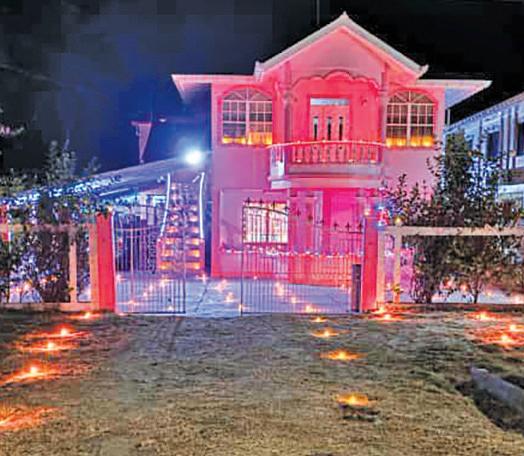


The Essequibo Coast, Region
Two (PomeroonSupenaam) was beautifully lit up on Monday eve -
tion, and unity. From early in the day, families were busy: cleaning and decorating their homes in preparation for the lighting festival. The aroma of sweet -
the air as trays of treats were prepared to share with families, neighbours and friends. Many also cooked special meals to serve visitors and relatives who came by to join
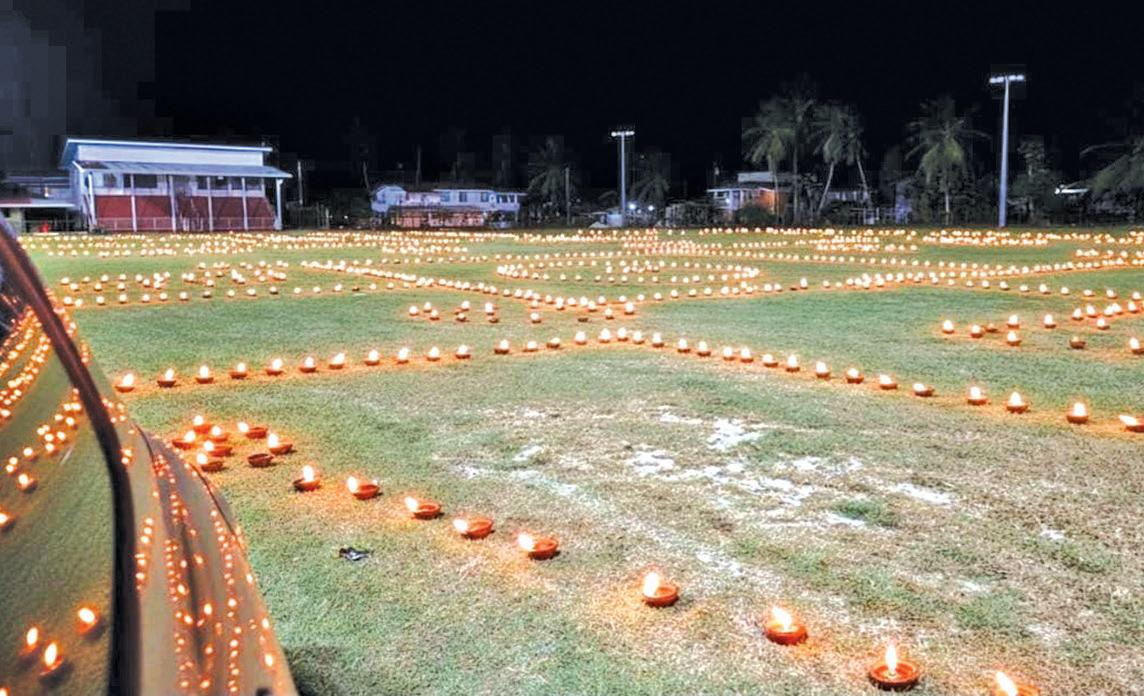
ning as Hindus celebrated Diwali, the Festival of Lights, with love, devo -
meats such as pera, gulab jamun, and barfi and delicious sweet meats filled
in the celebration. As darkness fell, homes and yards across the coast

were transformed with glowing diyas and colourful fairy lights. The shimmering lights could be seen from village to village, symbolising the triumph of light over darkness and good over evil.
Families performed Lakshmi Puja, offering prayers to Goddess Lakshmi for prosperity and happiness. The sound of bells and chanting echoed softly as families gathered together in worship and thanksgiving.
Children and adults enjoyed the evening by lighting sparklers and fireworks, which illuminated the night sky and added excitement to the celebration.
The atmosphere throughout the region was filled with happiness, peace, and togetherness as Essequibians celebrated Diwali 2025 in unity and love, keeping alive the true spirit of the festival.

Aman who was placed on $1 million bail back in January on a charge of driving dangerously resulting in the death of a pedestrian, was on Wednesday set free of the charge after Senior Magistrate Dylon Bess upheld a no case submission.
Joseph Gladwin also known as “Menty” is alleged to have caused the death of Andrew Adams 29, called “Greg”, by dangerous driving.
The incident occurred on January 24, 2024, on the Citrus Grove Main Access Road, Port Kaituma, Region One (BarimaWaini). He was charged with the offence, contrary to
Section 35 (1) of the Motor Vehicle and Road Traffic Act, Chapter 51:02.
Reports are that the accident occurred at 03:00hrs on January 24, a day before Adams would have celebrated his 30th birthday. Reports are that Adams was found with multiple injuries about his body and was rushed to the Port Kaituma Regional Hospital. However, he died while receiving treatment, relatives said.
Reports are that Adams called a sibling prior to the accident and requested a drop home. However, he changed his mind and decided to walk home. Adams’ sister stated that her brother was struck down
by a man called “Menty” who drove away after hitting her brother.
“Somebody else was passing and saw my brother and called the police. Then the ambulance pick him up and they take him to the hospital,” the woman had reported.
In a no case submission to the court, Attorney at Law Bernard DaSilva who represented Gladwin, told the court that while it is admitted that he was the custodian of motor car PYY 8713, on January 24, 2024. There is no evidence to suggest that he was involved in an accident. “The prosecution seeks to rely on the inference that, a mud guard was found at
the scene of where the body was lying. Notably this is a public road, where many vehicles traverse.
The mud guard that was retrieved from the scene, has no corroborative value. There was absolutely nothing to link the defendant’s car to the mud guard. There was no forensic comparative analysis, there was no attempt to even do a physical match by the investigators,” the Attorney argued.
Additionally, DaSilva stated there is no eyewitness called in support to prove, that the defendant drove dangerously on January 24, 2024.
“There is no evidence to suggest that the deceased died as a result of a motor
vehicle accident. The Post Mortem recorded the cause of death as multiple injuries. There is no opinion that, those injuries are consistent with a motor vehicle accident. The Pathologist was not called to explain his findings.” DaSilva, continuing his submission, told the court that it was not unreasonable to infer that the extent of injuries found on the deceased body as recorded in the Post Mortem report; if caused by the defendant’s motor car, would have caused extensive physical damage, so much so that; it will be too obvious to escape even the squinted eyes.
“Notably, the defect sheet, and the evidence of
the police sergeant coupled with the photographic evidence presented by the prosecution, did not support any theory of recent damages, blood stains, torn clothing, or any other corroborative evidence, found on the defendant’s car.”
The Attorney submitted that the prosecution failed to prove firstly that Julius Adams died by motor vehicle accident; and secondly that it was the defendant who committed the crime, thereby causing the death of Julius Adams.
After listening to the submissions, the Magistrate ruled that a Prima Facie case was not made out and dismissed the charge against Gladwin.

Air traffic controllers (ATCs) in Guyana are engaged in extensive training programmes to refine their skills and integrate cutting-edge technology, ensuring the safe and efficient management of the country’s rapidly expanding airspace. This comes amid the continuous emergence of new airlines and flight routes, reflecting the unprecedented growth of Guyana’s aviation sector. Monday marked the International Day of the Air Traffic Controller, a global celebration recognising the dedication and professionalism of controllers who keep air travel safe.
In a message on the occasion, Director General of the Guyana Civil Aviation Authority (GCAA), Lt. Col. (Ret’d) Egbert Field, A.A., commended Guyana’s air traffic controllers for their commitment to excellence and highlighted the ongoing initiatives to strengthen national airspace management. “To meet the increasing operational demands, several projects have been undertaken, including a study to reorganise the airspace in the Georgetown Flight Information Region (FIR), the addition of new aircraft to the registry, upgrades to infrastructure at

Ogle Airport, and the implementation of Standard Instrument Departures (SIDs) and Standard Terminal Arrival Routes (STARS) approaches,” Director General Field noted. Controllers are undergoing rigorous training programmes that integrate modern technology to streamline the flow of aircraft and maintain the highest standards of safety. These efforts are complemented by the expansion of the Civil Aviation Training School (CATS), which recently received the prestigious International Civil Aviation Organisation (ICAO) TrainAir Plus Accreditation, confirming its ability to deliver inter -
nationally recognised aviation training. A new CATS building is also planned at the Timehri Control Tower compound to accommodate additional personnel and further enhance training capabilities. The success of CATS’ virtual training programme has extended its reach across the Caribbean, demonstrating the school’s ability to provide specialised, accredited aviation education through innovative digital platforms. Guyana is also set to host the International Federation of Air Traffic Controllers Associations (IFATCA) conference in 2026, offering a platform for global knowledge exchange and collaboration.
To this end, Chairman
of the GCAA Board of Directors, Javed Shadick emphasised the indispensable role of controllers in connecting remote hinterland communities and ensuring the smooth operation of Guyana’s expanding aviation sector.
He emphasised the critical role ATCs play in connecting remote hinterland communities and highlighted the Government’s ongoing commitment to training that meets rigorous international standards. “The Civil Aviation Training School stands as a beacon of accomplishment, particularly following its acquisition of the prestigious TrainAir Plus accreditation, which elevates the institution to a new level of international recognition and operational prestige,” Shadick said.
The Board of Directors continues to ensure that ATCs receive the resources and operational environment necessary to perform their duties effectively. Plans for a new state-ofthe-art complex will provide a more conducive environment for staff and accommodate increased operational demands. “We extend our deepest gratitude and admiration for the individuals who safe -

guard the skies and keep our communities connected through the power of flight. Thank you to all Air Traffic Controllers for your dedication, effort, and unwavering zeal,” he concluded.
Currently, Guyana has 45 active air traffic controllers who collectively managed 72,867 aircraft movements this year. According to Director of Air Navigation Services, Rick Samaroo, on a busy day, a controller may handle an average of 45 radio transmissions per minute, maintaining 100 per cent accuracy to prevent collisions and ensure smooth operations.
“Equipment and systems over the years have improved efficiency, but the individual controller re -
mains the key element in a safe and reliable air traffic control system. Controllers are adaptable, skilled, and essential to the safety of all air travel,” Director of Air Navigation Services said. “Today is the International Day of the Air Traffic Controller, but we celebrate ATC every day. Controllers monitor aircraft from startup to parking, ensuring each flight is safe. Equipment and systems have improved efficiency, but the individual controller remains the cornerstone of a safe and reliable network. Controllers work in three shifts across Guyana’s airspace, managing thousands of flights with precision and dedication,” he added.

With reference to a social media post, Police ranks in Regional Division No. 2 (Essequibo Coast) in a
press release have stated that they have arrested a 38-year-old school teacher of Vilvoorden, of Essequibo Coast, following an incident
that occurred at Hack’s Rice Mill Office, Vilvoorden on Monday October 20.
Inquiries revealed that about 08:19h, a 31-year-old

businessman was in his office when the teacher entered and placed a container with a muddy substance inside the office.
The suspect allegedly then emptied the container and began throwing the substance on the businessman and around the office area.
A report was made to the Aurora Police Station, where the suspect was contacted and arrested.
Statements were obtained, and the suspect was placed on $15,000 station bail to appear in court soonest.
Following his arrest, several individuals visited the Aurora Police Station. However, no other arrests were made and no additional offences were reported in relation to the incident. Investigations are continuing, the release said.


Chief Medex within the Ministry of Health’s Regional Health Services Division, Carleen Howard-Mohabir, has revealed that approximately 50 per cent of Guyana’s Medical Extension Officers (Medex) workforce is currently stationed in hinterland regions, playing a vital role in expanding access to healthcare and strengthening preventative medicine in remote communities.
Speaking during the televised programme Health Matters, HowardMohabir highlighted that Regions One (BarimaWaini), Seven (CuyuniMazaruni), Eight (PotaroSiparuni), and Nine (Upper Takutu-Upper Essequibo) account for half of the country’s Medical Extension Officers (Medex), who often serve as the primary healthcare providers in villages where doctors are not permanently stationed.
“At least 50 per cent of our Medex are employed in the hinterland regions— Regions One, Seven, Eight, and Nine—and even along the coastal riverine communities,” she explained.
“Gone are the days when a patient had to wait days or weeks to reach Georgetown for treatment. Through technology and telemedicine, that’s no longer the reality.”
Medex training is crucial for Guyana’s healthcare system, particularly in providing primary care, especially in remote and underserved areas. Medex are mid-level healthcare professionals trained to provide a wide range of services, including health promotion, disease prevention, and basic medical care. Their training equips them to manage common ailments, identify those requiring referral, and even perform deliveries in some cases. Howard-Mohabir traced the evolution of the Medex programme, explaining that over the past 15 years, the Ministry of Health has introduced two training pathways: the traditional programme for midwives and registered nurses transitioning into public health, and an alternative pathway for new applicants with Caribbean Examinations Council (CXC) or post-sec -
Guyana continues to distinguish itself as a leading destination in the Caribbean, recording the highest percentage increase in visitor arrivals for the period January to July 2025. According to the Guyana Tourism Industry, with an impressive 18 per cent growth compared to the same period in 2024, Guyana outperformed every other reporting destination in the region.
The Caribbean Tourism Organisation’s monthly report also notes Guyana’s strong monthly gains: 22.8 per cent in January, 16.8 per cent in February, and 15.2 per cent in June, all well above regional averages. According to statistics from the Ministry of Tourism, Industry and
Commerce, this record growth was consistent across all seven months. The United States (US) (100,331 visitors), the Caribbean (76,247), Canada (17,783), and Europe (14,079) were among the top source markets.
An earlier report from the Department of Public Information (DPI) stated that the surge was supported by enhanced air connectivity, targeted marketing in key regions, a strong return of diaspora travel, major cultural and sporting events, and new tourism products that continue to broaden Guyana’s appeal to both regional and international visitors.
This consistent upward trend reaffirms Guyana’s growing position as one of the Caribbean’s fastest-rising destinations.
ondary qualifications. “We launched the alternative pathway in 2006 to expand access to training and reduce human resource gaps in the system,” she noted. “Since then, we’ve trained several batches of new Medex officers, and we continue to balance both pathways to ensure we maintain adequate coverage across all health regions.”
She added that many of these trained Medex are returning to their home communities, reducing turnover and strengthening trust between health workers and residents. “When regions identify and send their own young people for training, they tend to stay and serve. It builds ownership and stability in the community health system,” she emphasised.
Describing the Medex as the “bridge between doctors and nurses,” HowardMohabir explained that these officers perform a diverse range of duties depending on their postings— from managing outpatient

clinics and administering pharmaceuticals to assisting in deliveries and chronic disease management.
“Wherever a doctor cannot go, the Medex is there,” she said. “We are legally registered with the Medical Council and guided by the Chief Medical Officer. While we don’t perform surgeries, we diagnose, prescribe, deliver babies, and lead health promotion activities.”
Local recruitment
With this in mind, Howard-Mohabir made a strong appeal for regional leaders to identify and support local candidates for the Medex programme, emphasising that healthcare capacity improves when communities train their own professionals.
She also highlighted the numerous scholarships and online study options
now available through Government initiatives, which allow health workers to advance academically while remaining employed. “Many Medex officers have gone on to become doctors, optometrists, or postgraduate professionals,” she said. “You can start as a Medex and still elevate yourself through continuous learning. That’s the beauty of how our system has evolved.” With the continued rollout of telemedicine, training expansion, and stronger community engagement, Howard-Mohabir said Guyana’s Medex corps remains a pillar of the nation’s primary healthcare network, particularly in regions where access to doctors remains limited. “Our Medex officers are the heartbeat of primary healthcare in Guyana,” she affirmed. “We are ensuring that no matter where you live—on the coast or deep in the hinterland—you can access quality healthcare when you need it most.”

Ethehelbert Sauers, also known as “Berty”, a 48-yearold fisherman from De Veldt Village, Berbice River, was on Friday remanded to prison for the unlawful killing of a Berbice pensioner. Sauers appeared at the Albion Magistrates Court before Magistrate Michelle Matthias who read the capital charge to him. He was not required to plea to the charge which states that between Friday, October 10,

and Sunday, October 12, 2025, at De Veldt Village, he murdered 68-yearold Cledwin Gordon, also known as “Smokey”.
Sauers will have to return to court on November 17, 2025 when the matter comes up again. On that day the police will be expected to present the court with a report on the progress on the investigation.
Police in a release had stated that on Friday, October 10, 2025, the accused and the deceased were at a residence in
DeVeldt Village, consuming high wine and appearing to be intoxicated. An argument ensued between them, during which the accused allegedly struck the deceased on the left side of his collarbone, causing visible bleeding.
Later that same day, while they were in the victim’s boat, another argument broke out. During this confrontation, Sauers picked up Gordon’s cutlass and struck him to the neck, causing him to fall into the boat. Seeing that
the Gordon was still moving, Sauers is alleged to have then lifted him and throw him into the river before proceeding to a family members' location. The matter was reported to the police, leading to an investigation.
The following day police ranks visited DeVeldt Village, Berbice River following reports that Gordon had gone missing after reportedly being involved in an altercation with another villager.
During the visit several residents were interviewed and as a result of information received, a cutlass alleged to have been used during the altercation was recovered. The suspect was arrested and taken into custody and the cutlass was lodged as evidence.
On Sunday the body of Cledwin Gordon was discovered floating in the Berbice River in the vicinity of DeVeldt Village. The body was retrieved and examined by investigators after which it was escorted to the Bath Settlement Regional Hospital where it was pronounced dead.

Following recent claims suggesting that a teacher from BV Primary School was transferred after raising concerns about a pigeon infestation, the Ministry of Education (MoE) has issued a statement refuting the allegations.
According to the Ministry, "No teacher from BV Primary School has been transferred in relation to raising concerns about pigeon infestation, nor has

any such transfer been under consideration by the Ministry or the Teaching Service Commission (TSC). No teacher has been transferred or is being considered for a transfer." The Ministry further stated that "At no time has any directive been issued by the Ministry to relocate or penalise a teacher for voicing workplace concerns regarding conditions at their school."
In reaffirming its posi -
By Ron Cheong
When did the world change? According to British psychiatrist Dr Russell Razzaque, the shift began around 2010 and crystallised by 2016 – the year of both the Brexit referendum and the election of Donald Trump. Razzaque’s research focuses on how human beings respond to trauma and disruption, but this framework also offers a striking lens on our broader political and cultural environment: we have entered an alternate reality powered by smartphones, relentless stimulation and outrage.
This article began as an attempt to understand the apparent global unravelling of civility and the parallel rise of the extreme right. At first, I wondered if the growing sense of discord – despite the comfort and connectivity brought by technological leaps – was merely an illusion. Perhaps the digital age was simply exposing realities that had always existed but remained hidden. Then I encountered Razzaque’s work, which offered a clearer explanation. He argues that the world really has changed, and so have we. Our brains, he says, have been rewired. Since the convergence of smartphones, social media, and algorithmic feeds, humanity has entered a new mental ecosystem where attention is the most valuable currency. The human mind – wired for novelty and

emotion – has been subtly reprogrammed as the competition for our attention intensifies.
In the past, media consumption was largely passive: reading a newspaper or watching a half-hour newscast. Today, information flows in a ceaseless, interactive stream. Each swipe delivers a microburst of stimulation – humour, anger, desire, fear. Over time, this rewires our expectations. Ordinary reality, with its slower rhythms and nuanced reasoning, simply doesn’t compete. We now crave sharper edges: stories that spark emotion and outrage rather than invite reflection.
One consequence is that democracy itself is changing. Voters can no longer be assumed to act rationally – or even in their own interest. Competence alone rarely wins elections. Instead, spectacle, controversy, and constant social media presence often carry more weight than fairness, equality, optimism, or policy substance. This is the new habitat of growing seg-
ments of society caught in the digital vortex. It isn’t imagination: the world has changed, and so have people.
Media and the Economics of Disruption
It isn’t only social media that drives this transformation. Much of mainstream media has also been drawn into the same current. Confronted by shrinking attention spans, falling ad revenues, and the need to compete with the speed and immediacy of digital platforms, many outlets now favour conflict, outrageous headlines, and personality scandals. Complex policy discussions and constructive debates rarely fit into a viral clip. The result is a feedback loop: the public demands stimulation; the media delivers outrage; outrage shapes politics; politics feeds back into media spectacle. The moderate middle – where reasoned discourse lives – is drowned out by noise. Even nations once known for pragmatic politics are now polarised as algorithmic feeds re-
place shared public forums. The internet once promised the democratisation of information; instead, it has produced the fragmentation of truth. Fringe narratives – from conspiracies to historical revisionism – find oxygen in this fractured ecosystem. They spread faster than facts, propelled by algorithms that reward engagement, not accuracy. What was once outrageous now feels familiar, and familiarity breeds normalisation.
The Guyana Backdrop Closer to home, the pendulum has fortunately not swung as far as it has in other countries. The September 1 elections showed the majority of voters chose competence and performance. Nevertheless, the Razzaque phenomena was also evident in Guyana: manifested as spectacle, where scandal, United States (US) sanctions, braggadocios conduct and ostentation drew attention rather than raised alarm for many voters.
Maybe there were other reasons for some, but certainly for many it would have been the numbing to outrage brought on by immersion and constant stimulus of social media in which shock value is the hook by which many are drawn in and held captive - in this alternate reality nothing is appalling, and glitz and performative glamour are portrayed and peddled like a narcotic drug.
tion, the MoE added that "The Ministry recognises and respects the rights of teachers to draw attention to concerns about school infrastructure."
The statement continued, noting that "The Ministry remains committed to addressing any genuine reported issues of maintenance."
Additionally, the Ministry highlighted that "The Ministry will continue to follow established
protocols for any staffing changes, which are conducted in accordance with national policies, collective agreements and labour laws."
Concluding its statement, the Ministry urged all stakeholders to act responsibly, stating that "The Ministry of Education urges all stakeholders to practice the responsible dissemination of data, ensuring accuracy, confidentiality, and ethical use."

Guyanese-American writer, Shivani Jai met with President Dr Irfaan Ali Monday to present her debut novel, “What’s coming to you”, a psychological thriller that has captured the attention of readers worldwide for its heightened suspense and emotionally-charged storytelling.
A former Hollywood PR executive, Jai represents a
growing new wave of young Caribbean voices making their mark on the global entertainment landscape. Shivani Jai has a Master’s degree in communications and documentary production, and has spent 13 years in film and TV publicity. She lives in Los Angeles.
The novel is now available in paperback and eBook via Amazon.

Colombia has recalled its ambassador to Washington amid a furious war of words between Colombian president Gustavo Petro and Donald Trump over deadly US strikes on boats in the Caribbean.
The row took a sharp turn this weekend when Petro accused the US of “murdering” a Colombian fisher in an attack on a vessel in its territorial waters. Petro and his administration said the mid-September strike was a “direct threat to national sovereignty” and that the victim was a “lifelong fisherman” and a “humble human being”.
In response, Trump, who has claimed such attacks are designed to stop drug-smuggling to the US, called Petro an “illegal drug dealer” and vowed to end aid payments to Colombia, one of the largest recipients of US counter-narcotics assistance.
He also ordered Petro to “close up” drug cultivation sites, saying if not “the United States will close them up for him, and it won’t be done nicely”. Speaking aboard Air Force One, Trump added that he would announce new tariffs on Colombian goods.
In response, Colombia

recalled its ambassador to the US for talks in Bogotá on Monday, while its interior minister, Armando Benedetti, said the remarks were a “threat of invasion or military action against Colombia”.
Petro said that Colombia’s five-decade conflict stemmed from “cocaine consumption in the United States” and claimed American contributions had been “meagre and null in recent years”.
Analysts have warned the feud marks one of the most serious breakdowns of
relations between the longtime allies, and casts doubt over the future of security and counter-narcotics cooperation between the two countries. The row comes at a critical time for Colombia which is facing its worst security crisis in a decade.
Yet Colombia has not backed down, with the foreign ministry saying Trump’s statements “contain a direct threat to national sovereignty by proposing an illegal intervention in Colombian territory”. (Excerpt from The Guardian)
Minister of National Security Wayne Munroe Saturday advised Bahamians to “stay out of go fast boats leaving Venezuela”.
Munroe was responding to concerns over US strikes in Caribbean waters against what it says are drug traffickers leaving Venezuela.
“I would advise Bahamians to stay out of go fast boats leaving Venezuela,” he said.
He added, “We’re not going to be doing what the Americans are doing, but you would be well to stay out of their way.”
Munroe said that the reality is that it would be impossible to push back against the United States.
“If they determined to, for instance, deploy in international waters between The Bahamas and the US, what can we do to restrict them in finding what they say is their national interest?” Munroe asked.
He added, “I don’t see
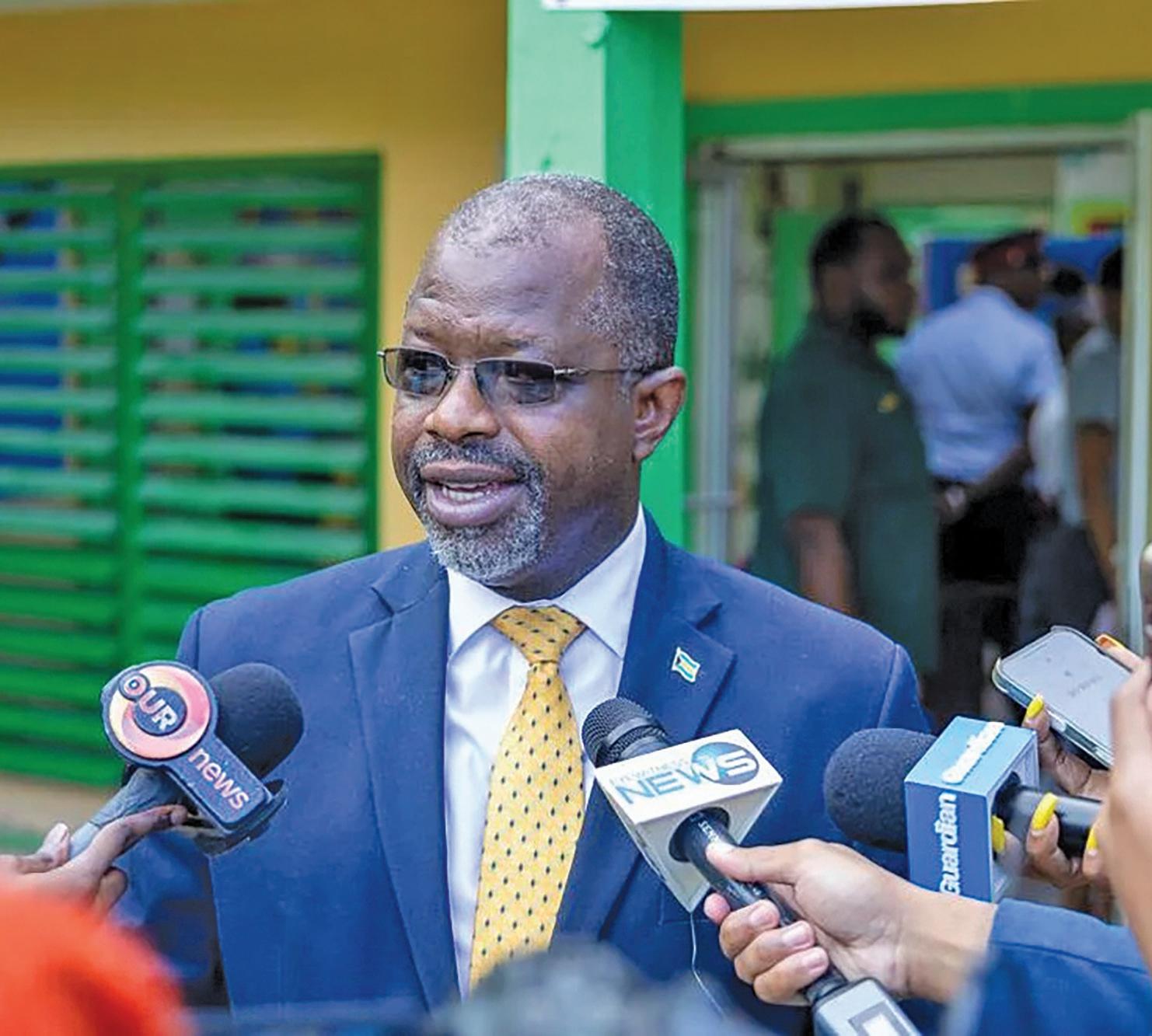
us sending the defense force out to contest them so we are unable to restrict them in the steps they see necessary to defend their national interest.
“If they decide to do that, we would have to seek to give our citizens warning to prevent them falling victims to, perhaps, a military strike.
“...In fact, if they were
to choose to sail in your harbor, there’s nothing you could do. It would be a breach of your sovereignty, and you could complain, but you couldn’t stop them.”
Munroe said that individuals believed to be taking part in illegal actions should be brought before the courts. (Excerpt from The Nassau Guardian)

An alleged gangster is dead after a two-motorcycle collision in Grange Hill, Westmoreland, Jamaica last Thursday.
The deceased has been identified as 22-year-old Alex Hill, otherwise known as Romaine, of a Bullstrod, Grange Hill address. Hill is said to be a member of a wellknown gang in Grange Hill and has been linked to several crimes.
Police reports indicate that on Thursday about 11:25 pm, Hill was driving his motorcycle along the Grange Hill main road, in the vicinity of the Top Geneva intersection, when he collided with another motorcycle.
The collision resulted in the two bikers being flung from their motorcycles.

According to the police, Hill was a member of the notorious Kings Valley Gang and has been linked to two wounding with intent incidents committed in Linten Pen, Grange Hill, on June 5, 2022 and on August 9, 2022.
Hill was also fingered in a store robbery along Fullersfield District in Grange Hill on April 9, 2025.
Hill was left unconscious after receiving serious head and upper body injuries. The other motorcycle driver received upper body injuries including a broken hand.
Both men were assisted to the Savanna-la-Mar Public General Hospital for treatment. However, Hill later succumbed to the injuries he received.
Two months later, Hill was accused of the murder of a man along the Crowder main road in Grange Hill on June 25, 2025, at 9:15 pm. In July, another member of the gang, 36-year-old Ricardo Hemmings, who was also known as Junior and Black Oil, was killed during a reported clash with members of a police team in Lime Hall, St Ann. (Excerpt from Jamaica Observer)
Bolivia has elected a centrist senator, Rodrigo Paz, as its next president, bringing an end to nearly 20 years of continuous rule by the Movement for Socialism (Mas) party.
With almost all votes counted, Paz, of the Christian Democratic Party, defeated right-wing candidate Jorge "Tuto" Quiroga in Sunday's run-off election with a share of 54.6%.
A severe economic crisis and infighting within Mas, which has dominated Bolivian politics since 2006, saw many voters wanting change.
Paz, 58, has said he will

end fuel shortages and address Bolivia's wider economic problems. In his victory speech, he said he would open up Bolivia to wider international investment and stimu-
Ja’Dore Wilson, who had been missing since September 17, was confirmed by police on Saturday as having been “located alive and well”, days after the search was joined by hundreds combing the island to find her.
The news brought an end to a search that included the use of drones in an effort to locate the 15-year-old, who had not been seen for 31 days.
Detective Inspector Kenten Trott, of the vulnerable persons unit, said that po-
lice “had cause to enter a residence in Pembroke where she was located”, based on information received by the public alongside a police investigation.
Mr Trott added that there was one person in custody at present, with an investigation continuing.
He declined to give details, including the age or gender of the person being held, but said police would “update as needed”.
He would not reveal whether the house where
Ja’Dore was found had been searched before. He declined to reveal where in Pembroke Ja’Dore had been discovered, or whether she was believed to have been held against her will.
“Those particular details will not be released at this time; however, it was part of our ongoing investigation,” he said.
Mr Weeks said Ja’Dore was back with her family and called on the community to respect their privacy. (Excerpt from the Royal Gazette)
The lifeless body of a man was found inside the warehouse of a Chinese-owned store located in the Villa María sector of the National District in the Dominican Republic (DR).
The discovery has caused consternation among local residents after it was confirmed that the man had died three days earlier without the store's managers re-
porting the incident to the authorities.
The information was released by the media outlet Panorama, which broadcast an audio recording in which a colonel recounted the incident and claimed that the incident had been kept secret by the merchants. According to the report, the deceased, who has not been identified, was found inside the store
after an emergency call. "He had been dead inside the store for three days and the Chinese didn't report it," the audio says, adding that the case was being treated confidentially until authorities recovered the body.
According to preliminary reports, the body was transferred to the Institute of Forensic Sciences (INACIF). (Excerpt from Listin Diario)



Oil prices settled at their lowest since early May on Monday as investors weighed a potential global glut, with US-China trade tensions adding to concerns about an economic slowdown and weaker energy demand.
Brent crude futures settled down 28 cents, or 0.46%, at $61.01 a barrel. US West Texas Intermediate futures settled down 2 cents, or 0.03%, to $57.52.
Both benchmarks fell more than $1 earlier in the session, and both closed at their weakest levels since early May.
Oil traders' concerns have shifted from under-supply to oversupply, the futures contract structure of the global benchmark Brent showed.
The six-month spreads for Brent and US crude futures both show contracts for earlier loading are trading below those for later loading, a structure known as contango, which encourages traders to pay for storing oil so it can be sold at higher prices when supplies are expected to have shrunk in the future.
The Brent contango, which emerged on Thursday for the first time since a brief appearance in May, was trading at its widest since December 2023.
The US crude futures contango emerged on Friday for the first time since January 2024.
"These glut fears are now descending onto the market, particularly looking forward into 2026. We will start to see floating storage pick up and inland tanks get filled," said John Kilduff, partner with Again Capital.
"This is a real bearish narrative that we have not seen in some time," Kilduff added.
Curbing some of oil's losses on Monday was news that a lobbying group whose board includes US firms such as OraclE, Amazon.com and Exxon Mobil is urging President Donald Trump's administration to immediately suspend a rule it says halted billions of dollars' worth of US exports and will prompt China and other countries to drop US firms from their supply chains.
Uncertainty remains over what may happen with Russian oil supply, with Trump saying again on Sunday that the United States would maintain "massive" tariffs on India unless it stops buying Russian oil. (Excerpt from Reuters)

ASpanish town has banned people from adopting black cats during Halloween over fears that the animals could be used for “ritual purposes”.
Officials Terrassa, in north-eastern Catalonia, claimed that there could be a spike in requests to adopt black cats, often associated with witchcraft, during the season by people wishing to use them for sinister purposes. Noel Duque, the deputy mayor and councillor for animal welfare, said: “We have issued instructions to stop the adoption and fostering of
One of the longest government shutdowns in US history just got longer after the Senate again failed to pass a funding resolution after a majority of Democrats continued their pressure campaign after the No Kings nationwide weekend protests.
The Senate vote fell for the 11th time with a vote of 50 to 43, with no new defectors from the Democratic side.
Mike Johnson, the House speaker, has for weeks kept the House shuttered on an extended recess, and defended his strategy as necessary to push Senate Democrats
into passing the House’s continuing resolution without policy additions. But Democrats have refused to support the measure without provisions addressing healthcare subsidies under the Affordable Care Act, which are set to expire at the end of the year.
Johnson, in a Monday morning press conference flanked by other Republican congressional leaders including Andy Harris, the House freedom caucus chair, said the reason for the shutdown was to appease Democratic voters, particularly putting blame on the No Kings rallies.
The stuffed vote also came after a prominent Republican lawmaker, representative Marjorie Taylor Greene, on Monday morning criticized Johnson’s strategy, calling on the House to return to session immediately.
The shutdown, which began on 1 October, has become the longest full government shutdown in US history, and the third-longest when including partial shutdowns. If it extends past Tuesday, it will surpass the 21-day shutdown of 1995-96 to claim second place. Only the 35-day partial shutdown during Donald Trump’s first
term, from December 2018 to January 2019, has lasted longer. The shutdown’s impact grew more severe on Monday as the Department of Energy’s National Nuclear Security Administration began furloughing approximately 1,400 federal employees responsible for maintaining and modernizing the US nuclear weapons arsenal. Chris Wright, the US energy secretary, is scheduled to address the furloughs at a press conference in Las Vegas later on Monday, a spokesperson told the Guardian. (Excerpt from The Guardian)
nited States
UPresident Donald Trump has called for Russia and Ukraine to freeze the war along current battle lines – a proposal that would see Moscow keep large areas of Ukrainian territory.
Trump told reporters late on Sunday that the two sides should just stop fighting and resolve the “details” over territory at future talks. The current front line runs through the Donbas region, an industrial hub.
“What I say is they should stop right now at the battle lines, go home, stop killing people and be done,” the US president said, adding that it would be difficult to negotiate de -

tails of a final resolution.
Asked about what would happen to Donbas, which has seen most of the fighting, Trump said: “Let it be cut the way it is. It’s cut up right now – I think 78 percent of the land is already
taken by Russia. You leave it the way it is right now. They can negotiate something later on down the line.”
Ukraine has previously insisted on reclaiming all of its land. Trump him-
self asserted last month that Ukraine can win militarily and recapture all of the territories occupied by Russia, which also includes the Crimean Peninsula and other areas in eastern Ukraine.
The US president, who had promised to swiftly end the war between Russia and Ukraine, is set to meet his Russian counterpart, Vladimir Putin, in Hungary in the coming weeks.
Trump hosted Ukrainian President Volodymyr Zelenskyy at the White House last week and said there is a chance to conclude the conflict quickly “if flexibility is shown”. (Excerpt from Al Jazeera)
Ablack cats on Halloween.
“This is serious. In Terrassa, if you want to adopt a black cat, it will have to be after Halloween. You will have to prove that you are going to take care of it and love it.”
Terrassa is not the only Spanish town that has acted to crack down on suspicious adoptions ahead of Halloween.
Madrid-based animal protection association La Posada Felina, which works with several foster homes, has also opted to close its adoption process this month. (The Telegraph)
mazon.com said on Monday that a cloud computing unit at its data center in northern Virginia had largely contained fallout from a widespread internet outage that caused global turmoil among thousands of sites, including some of the web's most popular apps like Snapchat and Reddit.
Amazon said it had addressed the underlying issue and was close to a resolution, but some users were still complaining of lingering difficulties using services such as digital wallet Venmo and video calling site Zoom.
The disruption knocked workers from London to Tokyo offline and halted others from conducting normal everyday tasks like paying hairdressers or
changing their airline tickets.
It was the largest internet disruption since last year's CrowdStrike malfunction hobbled technology systems in hospitals, banks and airports, highlighting the vulnerability of the world's interconnected technologies. It was at least the third time in five years that AWS's northern Virginia cluster, known as US-EAST-1, contributed to a major internet meltdown.
Amazon did not address a request for more clarity about why that particular data center keeps being impacted, instead pointing to an online statement that said the matter had been "fully mitigated."
The problems stemmed from what is known as the
Domain Name System, or DNS, which prevented applications from finding the correct address for AWS's DynamoDB API, a cloud database relied upon to store user information and other critical data.
After hours of disruptions, many applications were gradually coming back online in the afternoon in the US But AWS acknowledged that elevated errors were still affecting several services.
Snapchat last had over 7,500 reports on Downdetector, lower than the peak of more than 22,000 but still higher than the 4,000 outage instances at around 7:00 a.m. ET.
Artificial intelligence startup Perplexity, cryptocurrency exchange
Coinbase and trading app Robinhood, all experienced platform disruptions and attributed them to AWS.
Amazon's own services, including its shopping website, Prime Video and Alexa, were also hit, although Downdetector last showed a decrease in severity.
Fortnite, owned by Epic Games; Clash Royale and Clash of Clans were among the gaming platforms affected. Uber Lyft was also knocked down in the United States.
In a post on X, Signal President Meredith Whittaker confirmed the messaging app was hit by the outage as well, though billionaire Elon Musk, who owns X, said his platform continued to work.
(Excerpt from Reuters)
















Think on the move, and you'll devise a plan that surpasses expectations. Trust your instincts and move forward with confidence. It's up to you to be a leader and to make things happen.
















Your savvy ideas and dedication will open doors and win support. It's how you represent yourself that will make a difference. Stand tall and execute your plans with courage.
Listen and learn. Positive changes result from being diligent and leaving nothing to chance. Socializing will lead to opportunities and give you plenty to consider.
Follow the money and engage in events that show you the way to success. Pump yourself up and find an outlet for your skills. Use intelligence to reach your goals.
Take control over domestic situations that face change or require fine-tuning. Figure out how to keep things running smoothly. A tall order will offer a healthy gain.
Simplify your life, start conversations and distance yourself from out-ofcontrol individuals. Be the one with discipline and foresight to take the path that protects you, your assets and your possessions.
Tackle what's necessary first. Do what needs doing without complaint. Don't sign up for more than you can handle or anything that has hidden costs. Spend only what's necessary.
Don't hesitate when speed is of the essence. Think and follow through, and you'll gain ground. Network, negotiate and use your charismatic charm to achieve your objectives.
Deal with domestic matters cautiously. Hesitation and uncertainty will mount if a decision is necessary. Maintain your status quo by consistently delivering high-quality work.


Take charge without malice. It's how you go about getting others to do things for you that will lead to your success. Work your magic, and you'll get the results you hope for.



A change at home will save you time and money. Refuse to let mixed emotions lead to unnecessary costs. Invest more time in cultivating a positive self-image.

Urge others to respect you and your property. Connect with people on a level playing field and avoid giving anyone the advantage over you. Know what you want, and don't stop until you reach your destination.






Phil Salt and Harry Brook combined to blow New Zealand out of the water in the second T20 International (T20I), as England sealed a dominant 65-run win in Christchurch to take an insurmountable 1-0 lead in this three-match series.
Both Salt (85 off 56 balls) and Brook (78 off 35) were independently brutal, but came together in devastating fashion with a partnership of 129 from just 69 deliveries. England's 236 for 4 was a new record T20I score at Hagley
not helped by two dropped catches that would have given them a more realistic target.
The one that mattered more gave Brook a life on 40, after he had successfully overturned a caught-behind decision on 22. The visiting Captain was at his destructive best, with 54 runs through boundaries, including five sixes, two of which were carted out of the ground. Despite Kyle Jamieson accounting for both Brook and then Salt in the space of three deliveries, Tom Banton's unbeaten 29 from 12 added the re-

Oval, comfortably bumping off the previous best of 208 with 10 balls still to go in their innings. New Zealand were eventually dismissed for 171 with two overs to spare.
Mitchell Santner's decision to bowl first upon winning the toss was a case of rinse-and-repeat; both teams opting for the same XIs after Saturday's washout in
cord-busting cherry on top.
Brydon Carse's twin strikes in the second over clipped the Kiwis' wings in pursuit of 237. And though Tim Seifert and Mark Chapman restarted the chase with an engaging stand of 69, their respective demises to the spin duo of Adil Rashid and Liam Dawson all but confirmed the result.


Santner did his utmost to inject some late jeopardy with a breezy 36 off 15, before falling to Rashid's final delivery, the legspinner finishing a solid evening's work with 4 for 32. Luke Wood then had the honour of capping off victory in the 18th over with two dismissals in four deliveries, with New Zealand losing all 10 wickets to catches.
Salt in cruise mode
This new iteration of Salt is developing a knack of cashing in after missing out. His career-best 141 not out against South Africa in September came two days after a first-ball duck. And with as many days since 3 off 4 in the first T20I at Hagley Oval, he looked on course for a fifth century in the format.
No doubt Salt will feel he missed out in a different way, falling for 85 when he was caught on the long-off sponge, 15 short of three figures with as many balls of the innings remaining. Once again he spearheaded a record total a month after leading the breaching of 300. He upheld his first-over re-

sponsibility by putting Matt Henry's second ball on to the grass bank at midwicket, then whipping behind square leg along the floor once Henry had corrected. By the time Jos Buttler faced his second ball, Salt had already struck 20 from nine.
That was as dominant as Salt was in his stands. Once Buttler was dismissed for 4, he adopted a secondary role during his work with Jacob Bethell (scoring 19 of their 44 together) and Brook (46 of their 129). Hardly a passenger, but more than happy to cede the driving.
Perhaps the best example of his continued intent was his dismissal, attempting a second six (and 13th boundary) two balls after Brook had holed out at deep midwicket. He now has more T20I runs than Jason Roy, despite 22 fewer innings, moving up to sixth for England run-scorers in the format, with a strike rate of 168.12 that is at least 16 ahead of any of those in the top 10.
Brook does as he says "We've got such a strong batting line-up, we can keep going," Brook said after a second coin toss of the series had gone against him on this tour. The response came after the England Captain seemed nonplussed with being asked to set a total.
And how. Arriving in the eighth over, Brook, a straight-talker, got straight down to business. He raced to 19 off six, courtesy of three successive boundaries off Santner, with two sixes – the first into the crowd, the second over the roof at midwicket – sandwiching a craftily-ramped four.
A second six beyond the confines of this boutique ground allowed him to knock two singles for a 22-ball half-century – his fifth overall in T20Is and first as Captain.
He celebrated with 21 off the returning Jamieson in the following over. Earlier, he had provided 14 of the 20 picked
off from Jimmy Neesham's one-and-only over.
Both were examples of constantly putting bowlers under pressure, already a well-worn mantra in his six months at the helm. That knack of leading by example is not only why he was handed the keys to the white-ball job, but installed as Test Vice Captain ahead of this winter's Ashes.
Dawson shows nous
That both teams opted for two spinners owed more to trending towards 2026's T20 World Cup in India and Sri Lanka. While New Zealand's returned 1 for 77 from seven overs, England's bagged 6 for 70 in eight.
The fact both wanted to bowl first showed there was a collective misreading of conditions. And as the lights took over for the second half, the pitch did begin to grip. It was, in more ways than one, a great toss to lose.
There is not much more to be said of Rashid, his status as one of England's most-valuable white-ball cricketers set in stone long before becoming the first visiting bowler to take four or more in a T20I at this venue. But it was Dawson, who laid down his credentials to partner the leggie for next year's global tournament.
The left-arm spinner's wiliness was on show in his first three overs, manipulating his angles to remove Mark Chapman and then the dangerous Michael Bracewell. It took until Dawson's 16th delivery for New Zealand to find a boundary off him – Neesham smearing a four to midwicket – and even then, heading into his final over, the Hampshire all-rounder had an impressive 2 for 15 by his name.
Twenty-three conceded off a scatty fourth messed up those figures. Two sixes from Santner were responsible for the untidy finish, triggering five wides as Dawson bunged a full toss down the leg side in an attempt to hide the ball from the home skipper's arc. Nevertheless, Santner's 0 for
41 earlier in the piece high lighted just how impressive England's own southpaw twirler had been.
For all England's enter prise with the bat, there was unnecessary generosity from their hosts. You do not usual ly associate slack fielding with New Zealand, but two drops tilted this match against them significantly in Christchurch.
Seifert was responsible for missing the first and tough er chance. Jacob Duffy, hav ing pulled out of the previous delivery as Bethell gave him self room to the leg side, dug one in short with a bit of cut. Bethell, on 7, went for his pull shot, only to top-edge high to wards short third.
Seifert had tracked it well, but was undone by the stiff north-west breeze, ending up on his back, palming the ball just before he hit the deck.
Though Bethell "only" man aged 17 more before being dismissed with the last ball of the sixth over, his back-toback sixes off Bracewell lifted England's powerplay score to 68 for 2.


That it was the highest at this ground was a sign of things to come, but that, too, could have been avoided. At the start of the 13th over, Henry returned and was greeted with a lofted straight heave from Brook. Somehow, Neesham, having just bowled an over that cost 20, botched a
straightforward catch at longon allowing Brook a life. They did not have to count the cost of dropping Sam Curran twice on Saturday, the all-rounder's 49 not out hustling England to a respectable total of 153 before the rain intervened. Here, the price of the combined errors was 55 – a figure New Zealand only made up for in their innings with the final ball of the power play. (ESPNcricinfo)
Atournament lacking in genuine tight finishes has now produced two in two days, as Bangladesh and Sri Lanka
nal contention, while Sri Lanka live to fight another day.
This was a chase that Sri Lanka were behind for around 48 overs, but in a tantalising final dash they picked up five wickets and gave away two runs off the final nine deliveries of the game, as Bangladesh were unable to close out a game that they had controlled for

Sri Lanka Women (50 ovs maximum)
Vishmi Gunaratne lbw
b Marufa Akter 0
Chamari Athapaththu (c) lbw
b Rabeya Khan 46
Hasini Perera lbw
b Shorna Akter 85
Harshitha Samarawickrama run out
(Shorna Akter/†Nigar Sultana) 4
Kavisha Dilhari st †Nigar Sultana
b Nahida Akter 4
Nilakshika Silva c Nishita Akter Nishi
b Shorna Akter 37
Anushka Sanjeewani †
c & b Shorna Akter 2
Sugandika Kumari lbw
b Nishita Akter Nishi 1
Udeshika Prabodhani
b Rabeya Khan 8
Malki Madara run out
(Fargana Hoque/Rubya Haider) 9
Inoka Ranaweera not out 2
Extras (lb 1, w 3) 4
Total 48.4 Ov (RR: 4.15) 202
Fall of wickets: 1-0 (Vishmi Gunaratne, 0.1 ov), 2-72 (Chamari Athapaththu, 12.4 ov), 3-87 (Harshitha Samarawickrama, 16.4 ov), 4-100 (Kavisha Dilhari, 19.1 ov), 5-174 (Nilakshika Silva, 31.4 ov), 6-178 (Anushka Sanjeewani, 33.2 ov), 7-181 (Sugandika Kumari, 34.2 ov), 8-182 (Hasini Perera, 35.3 ov), 9-200 (Udeshika Prabodhani, 47.4 ov), 10-202 (Malki Madara, 48.4 ov)
Bowling O-M-R-W
Marufa Akter 5.4-0-36-1
Nishita Akter Nishi 10-0-35-1
Nahida Akter 7-1-30-1
Rabeya Khan 9-1-39-2
Ritu Moni 6-0-33-0
Shorna Akter 10-4-27-3
The final scorecard will read that Chamari Athapaththu picked up figof 4 for 42, but three of those came in a game-stealing final over, where Bangladesh lost four wickets off the first four deliveries – a run-out in the middle ensuring it was not an Athapaththu
Up until then Nigar Sultana had anchored the chase, if not expertly then at least safely. Her 77 off 98 came mostly as part of two major partnerships – the first 82 off 120 with Sharmin Akhter and the second 50 off 58 with Shorna Akter – during which Sri Lanka were like passengers aboard a rudderless ship, just merely on for the

But to stick
Sobhana Mostary 1-0-1-0
Bangladesh Women (T: 203 runs from 50 ovs) Fargana Hoque run out (Samarawickrama) 7
Rubya Haider c †Sanjeewani
b Prabodhani 0
Sharmin Akhter not out 64
Sobhana Mostary c Gunaratne b Kumari 8 Nigar Sultana (c)† c Silva
b Athapaththu 77
Shorna Akter c †Sanjeewani
b Athapaththu 19
Ritu Moni
b Kumari 7
Rabeya Khan lbw
b Athapaththu 1
Nahida Akter run out (Silva) 0 Marufa Akter lbw
b Athapaththu 0
Nishita Akter Nishi not out 1
Extras (w 11) 11
Total 50 Ov (RR: 3.90) 195/9
Fall of wickets: 1-2 (Rubya Haider, 1.5 ov), 2-24 (Fargana Hoque, 10.2 ov), 3-44 (Sobhana Mostary, 15.3 ov), 3-126* (Sharmin Akhter, retired not out), 4-176 (Shorna Akter, 45.1 ov), 5-193 (Ritu Moni, 48.4 ov), 6-194 (Rabeya Khan, 49.1 ov), 7-194 (Nahida Akter, 49.2 ov), 8-194 (Nigar Sultana, 49.3 ov), 9-194 (Marufa Akter, 49.4 ov)
Bowling O-M-R-W
Malki Madara
7-0-19-0
Udeshika Prabodhani 7-1-29-1
Sugandika Kumari 9-0-38-2
Inoka Ranaweera 10-0-42-0
Chamari Athapaththu 10-0-42-4
Kavisha Dilhari 7-0-25-0
with the analogy, this was not a ship moving particularly swiftly, and indeed it was almost entirely of Bangladesh's own making that this chase went as deep as it did. On a pitch, not offering much for the spinners – of which Sri Lanka are stocked full of – Sri Lanka were resigned to simply keeping things tight, unable to really impose themselves on the game with the ball as they would have liked.
But with a pretty chaseable target of 203 on the board, Bangladesh were guilty of being overly cautious – perhaps bearing in mind their poor batting efforts earlier in the tournament – as they inched along.
It meant that when Bangladesh faltered at the death, Sri Lanka were perfectly poised to pounce, though it really had no business getting to that point in the first place.
Earlier however, it was Sri Lanka who had been slowed to a crawl, after a stunning mid-innings collapse had halted them. Hasini Perera struck a maiden international fifty in her 143rd match, a shining light in an otherwise-disjointed batting effort and was one of only three batters – Athapaththu (46) and Nilakshika Silva (37) the other two – to reach double digits.
Both Athapaththu and Hasini brought up mile stones – 4000 and 1000 One-Day International (ODI) runs, respectively –during their knock as well, while Hasini was eventually named Player of the Match.
Shorna once more proved decisive – despite being in troduced at the halfway point of the innings – as she picked up figures of 3 for 27, including the cru cial wickets of both Hasini and Nilakshika. The rest of the wickets were spread out, with only Ritu Moni going wicketless.

of play.
After this point, Sri Lanka were both unfortunate and architects of their own demise. A fledgling partnership of 15 between Harshitha Samarawickrama and Hasini was brought to an end after the former called for a non-existent second run and found herself a metre short.
If that was self-inflicted, the next wicket was pure unadulterated bad luck. Kavisha Dilhari chopped an
ed wildly, Sri Lanka had suddenly stumbled from 72 for 1 to 100 for 4, a worrying blip with them being a batter light after replacing all-rounder Piumi Wathsala with seamer Udeshika Prabodani. Thankfully for the Lankans, in Hasini and Nilakshika they had the exact counter-attacking pair the occasion called for.
Together they strung a 74-run stand off just 75 deliveries. It was a period in which batting seemed the
transpired, Nilakshika's innings came to an end prematurely, as she shanked an on-side heave off Shorna to short third.
This wicket proved to be a catalyst for Sri Lanka's most devastating collapse, with them losing their next three wickets for just eight runs – Shorna getting two of them. From then on, Sri Lanka's innings slowed to a trickle as they sought to bat time, be fore eventual

Bangladesh were sloppy in the field, missing several chances, including run-outs and stumpings, but they were also spot on with their reviews. Despite this, Sri Lanka had at several points been on the up – in control, even. There was the 72-run stand between Athapaththu and Hasini after the fall of that first wicket, which had Sri Lanka romping along at nearly a run a ball.
On a wicket with few demons, Athapaththu's 46 off 43 included six boundaries and two sixes. For the most part she looked unfazed by what Bangladesh threw at her, so when she was trapped lbw by one that snuck past her forward defence, it was against the run

ball promptly bounced past the stumps, struck keeper Sultana, and bobbled on to the stumps. Bangladesh went about their business after this, the fielders even getting back into their positions, but the third umpire was alert and used the Smart Replay system in effect at this tournament to alert the on-field umpires to a possible stumping.
As it turned out, Dilhari's back foot had momentarily lifted off the ground as she searched for balance. It was in that moment the bails had lit up – a fitting tribute to the Diwali celebrations around the stadium.
As Bangladesh celebrat-
regularity. If there was one criticism – and this would be one across Sri Lanka's innings – it would be their lack of strike rotation.
Despite the pair striking nine boundaries (including three sixes) across their partnership lasting a shade over 12 overs – nearly a boundary an over – they were unable to usher in a run rate above six an over. This was a problem that would plague Bangladesh's innings as well, later on.
Perhaps it was their awareness of the lack of batting to follow that kept them in check, but it was unusual to see so many tossed-up deliveries of spin dead-batted away. As it
bowled out with eight deliveries remaining. Their final 103 balls saw 28 runs scored and six wickets fall, a feat somehow surpassed by Bangladesh. (ESPNcricinfo)


As time winds down to the Terrence Poole National Intermediate Championships, set for October 25-27 at the National Gymnasium, several gyms across the length and breadth of Guyana are intensifying preparations for the competition.
Among them in the heart of the capital city is the Andrew Lewis Gym based in Albouystown that is leaving no stone unturned in the build-up to the competition.
This year’s edition of the National Intermediate Championships carries added significance, as it will honour the man it has now been named for – the late Terrence Poole, the long-serving Technical Director of the Guyana Boxing Association (GBA), who passed away in October 2024. Poole was a towering figure in Guyanese boxing, dedicating over four decades to the sport as a coach, coordinator, and mentor to hundreds of athletes nationwide.
Coach at the Andrew Lewis Gym, Lennox Daniels has placed his fighters in a rigorous training regimen. Daniels explained that while some boxers did not get a chance to compete recently, the focus was now on refining fundamentals ahead of the championships.

“Right now, we just finished the tournament yesterday, and all the guys didn’t get to fight, so we got to improve on them next week. All the basic things like clubs work,
The much-anticipat-
ed Berbice Football Association (BFA) Senior Men’s League kicked off in grand style on Saturday, with an opening round which saw victories for Ithaca and Paradise, while Trafalgar and Cougars played to a dramatic 2-2 draw.
The opening match of the tournament was a tightly-contested affair between Ithaca and Black Sharks, with the lone goal of the game coming early.
Royan Amsterdam found the back of the net in the 11th minute, giving Ithaca a lead they would resolutely defend for the remainder of the match. Despite a few chances created by Black Sharks, Ithaca’s defence held firm to secure all three points and start their campaign on a winning note.
Game two was a showcase of attacking football

demonstrating clinical finishing and great positional play.
bag work, pad work we’re doing to make sure we’re ready,” Daniels said.
The veteran coach expressed confidence in his fighters’ ability to deliver under pressure, noting that the emphasis would be on translating gym work into competition results. “I expect to see what they have learned; I wanted to see they go there and adapt it, basically. They’ve been through a lot of words and we’ve even been mentoring them, so this time, when they go there, they just execute it in the right form,” he added.
The National Intermediate Championships is one of the GBA’s marquee events on the annual calendar, designed to provide a competitive platform for emerging boxers to showcase their skills. This year’s tournament doubles as a tribute to Poole’s enduring legacy, bringing together gyms and athletes from across the country in what is expected to be a spirited and emotional showcase of local talent.
The GBA has extended invitations to clubs nationwide and is encouraging the public to come out and support the event, which not only celebrates competition but honours one of Guyana’s most respected sports figures.
The Georgetown Cricket Association (GCA)-NBS SecondDivision 40-Over competition continued over the weekend with two exciting encounters featuring Everest Cricket Club versus Diplomats and Muslim Youth Organisation (MYO) versus Guyana Defence Force (GDF).

as Paradise dominated Kildonan Young Warriors with a commanding 4-1 victory. The goals flowed freely for Paradise. Devon Fraser opened the scoring in the 13th minute with a wellplaced strike. Cortland Richman then took centre stage, netting a brace in the 60th and 65th minutes,
Jewel Fraser added the final goal in the 70th minute, sealing a confident win for Paradise. The Young Warriors managed a consolation goal, but it was little comfort in a game where Paradise dominated possession and territory.
The final match of the evening delivered high drama as Trafalgar and Cougars battled to a thrilling 2-2 draw.
Cougars drew first blood when Keron George converted from the penalty spot in the first half. However, Enriquez Lewis responded swiftly for Trafalgar, slotting home the equaliser to make it 1-1.
In the second half, a Trafalgar own goal gifted Cougars the lead once again. But with time winding down, Civion Arokium came up big for Trafalgar, scoring a late equaliser that rescued a point for the West Berbice side.
The action continued at All Saints Ground on Monday with another triple-header scheduled: In the first game, Fyrish v Paradise – Paradise looked to build on their opening win.
Game two: Ithaca v Trafalgar – A West Berbice showdown with both teams looking to stay unbeaten.
Game three: Cougars v Kildonan – Both sides aimed to bounce back after failing to secure wins in their opening fixtures.
The league, which is sponsored by the Ministry of Culture, Youth and Sport, promises intense competition and meaningful football development for the Berbice region. With prize money totalling $1.1 million, individual accolades are up for grabs.
Everest Cricket Club won the toss and elected to bowl first, a decision that quickly paid off as Diplomats suffered a batting collapse, being bowled out for 101 in 26.1 overs. Opening batsman Deryck Babb provided the only real resistance, scoring a solid 46 from 62 balls, hitting seven fours and one six. He found brief support from Munesh Outar, who contributed 22, but no other batsman reached double figures. The bowling honours were shared between Devindra Krishnalall, who took 4 for 12 from 7.1 overs,

Varun Mangla gave them a flying start with 39 off 25 balls (eight fours), while Mathura capped off

and Nityanand Mathura, who also bagged four wickets in an excellent spell. In reply, Everest made light work of the chase.
a superb all-round performance with an unbeaten 46 from 33 balls, featuring six fours and one six. Everest reached 102 for 2
in just 12.4 overs, sealing a commanding eight-wicket victory. In the other fixture, MYO won the toss and chose to bat first. They posted an imposing 300 for 9 in their 40 overs, powered by Dameon Cecil’s explosive 61 from 45 balls (8 fours, 3 sixes) and Ricky Debydial’s steady 50 from 60 deliveries. Cameos from Leon Cecil (30) and Keon Morris (30) added valuable runs down the order. For GDF, Rashaad Gaffur and Shamal Angel each claimed two wickets.
Chasing 301, GDF’s innings was anchored by a blistering 114 from 86 balls by Angel, who smashed 12 fours and five sixes in a superb counterattack. Michael Deonarine supported with 48 from 35 balls, but the effort fell just short as GDF were bowled out for 292 in 39.3 overs, handing MYO a narrow eight-run victory. Jaurav Ramesh led MYO’s bowling with 3 for 51, ensuring his team held their nerve to secure the win.


Director of Sport, Steve Ninvalle has extended heartfelt congratulations to Guyana’s Rosanna Fung, following her historic triumph at the International Federation of Bodybuilding and Fitness (IFBB) World Championship.
The event was held as part of the prestigious Binous Classic in Dubai, United Arab Emirates (UAE), where Fung became the first athlete in Guyana’s history to win a World Championship title at the IFBB.
Ninvalle described Fung’s victory as “a proud moment” for sports in Guyana, noting that her accomplishment has elevated the nation’s profile in international bodybuilding and demonstrated the potential of Guyanese athletes to excel on the global stage.
“The National Sports Commission (NSC) joins the Ministry of Culture, Youth and Sport, the Government of Guyana, and the people of Guyana in congratulating Rosanna Fung on her continued success and climb on the international stage of bodybuilding,” Ninvalle said.
The Director of Sport added, “Her victory is not just a personal milestone, but a national achievement that will inspire generations of athletes to follow their passion and pursue excellence.”
Competing in the highly-competitive Wellness category, Fung delivered a world-class performance that outshone elite competitors from across the globe.
Her poise, symmetry, conditioning, and stage presence impressed both judges and spectators, earning her the coveted gold medal, which is a first for Guyana at the IFBB World Championship level.
The Binous Classic, widely regarded as one of the largest and most respected bodybuilding shows and expos in the Middle East, attracts top-tier athletes and fitness professionals from around the world.
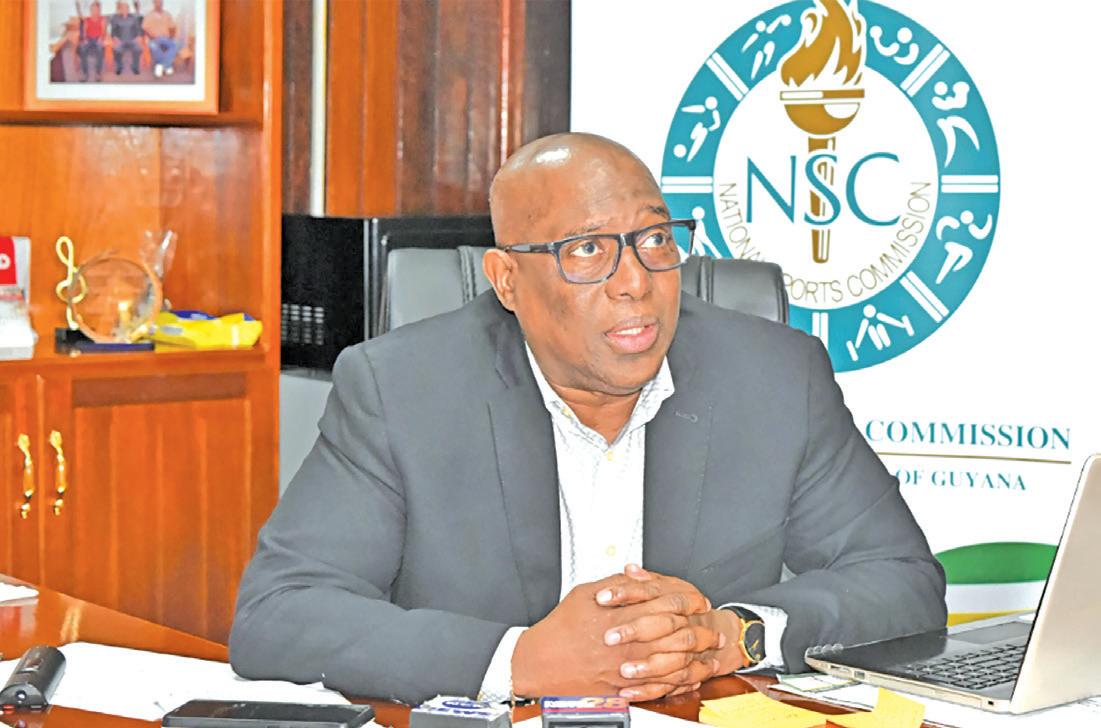
signalled not only her individual brilliance but also Guyana’s growing presence and influence within international fitness and bodybuilding circles.
“Rosanna’s story, from humble beginnings in the sport, to earning her IFBB Pro Card, and now proudly representing Guyana as a world champion, speaks volumes about the passion of our athletes and the spirit of our people,” Ninvalle stated.
“It shows that with hard work, discipline, and belief, Guyanese athletes can stand shoulder to shoulder with the best in the world.”
He added that her achievement reflected the success of the many athletes, coaches, and organisations who continue to build Guyana’s reputation as a rising sporting nation.
“This victory belongs to Rosanna, but it also belongs to Guyana, to every young athlete who dreams of great-


Ninvalle pointed out that Fung’s victory on that stage

Four exhilarating football games were on the cards on Sunday at the Ministry of Education (MoE) Ground, Carifesta Avenue as the Republic Bank Secondary Schools League kicked off.
The proceedings began with a vibrant march-past of the eight participating teams in the League, who will, over the next seven weeks, compete for top honours.
Immediately prior to the tournament’s official kick-off, Republic Bank Internal Audit Manager Oral Rose spoke, reiterating the company’s commitment to youth investment.
“Republic Bank is proud to invest in our youth and in our communities and that’s why we have you participating in this tournament for a second year. We want you to have fun and play with respect. As we continue to invest in this football tournament, I want you to be encouraged that Republic Bank is concerned about the youth and communities that

we invest in,” Rose shared.
When the on-field action began, defending champions Chase’s Academic Foundation found themselves backed against a wall as they took on Abram Zuil Secondary in the opening fixture.
The Region Two outfit got ahead first when Omar Kendall stunned the Chase’s keeper with a long shot in the 14th minute. However, in the 22nd minute, Chase’s Juslyn Halley found the back of the net to level the score. Just when it seemed like the two teams would have to settle for a drawn result, Isaiah Ifill came to Chase’s rescue with a tapin, in the 55th minute which eventually became the game winner.
A similar 2-1 result followed when Three Miles Secondary came up against West Ruimveldt Secondary. The Georgetown side got ahead first, through Jeremiah Griffith
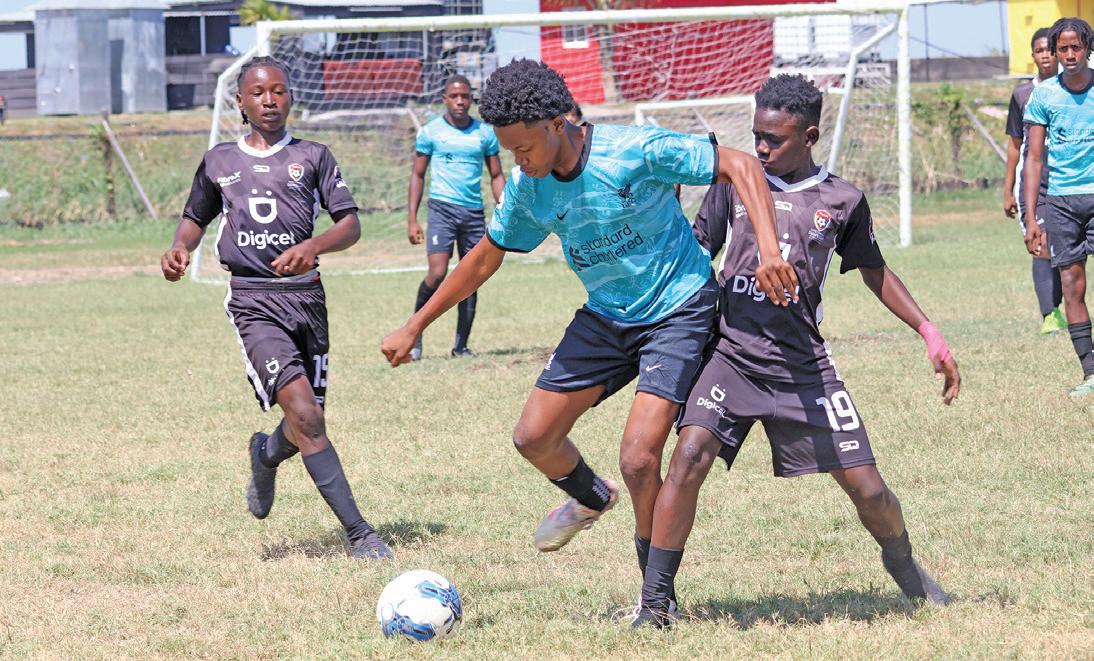
in the 10th minute. West Ruimveldt held on to their lead for much of the game, until Lebron Mendonca connected a stellar shot in the 55th minute for the equaliser. Then, in the 70th minute, Joshua James found the back of the net to hand his side the victory in the final minutes of the game.
Again, a 2-1 result was witnessed, this time going in favour of South Ruimveldt Secondary against President’s College. Jadon Edwards opened the scoring for South in the seventh minute while Tyrese Pemberton added a second to their tally in the 56th. Their goals were punctuated by President’s College’s consolation off the boots of Daniel Alexander in the 29th minute.
Charlestown Secondary brought the curtains down on the day’s proceedings with a shocking 2-0 victory over reigning Milo Secondary School Champions Dolphin Secondary. Dilshawn Alleyne was responsible for Charlestown’s goals, registering a brace in the 51st and 65th minutes.
The Republic Bank Secondary Schools League will continue next Sunday at the same venue.